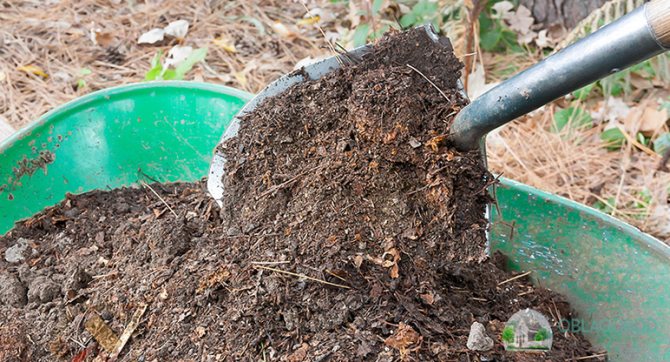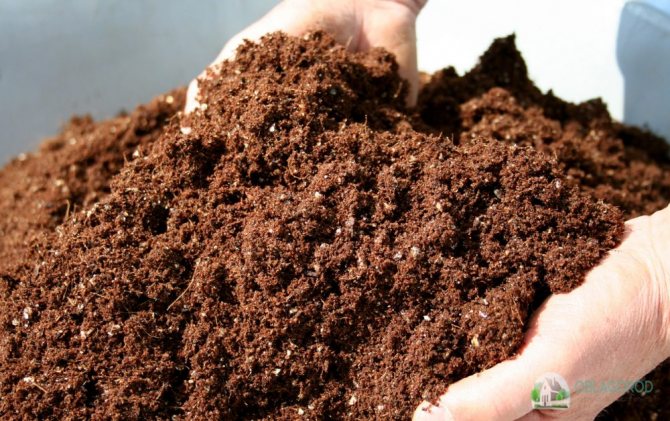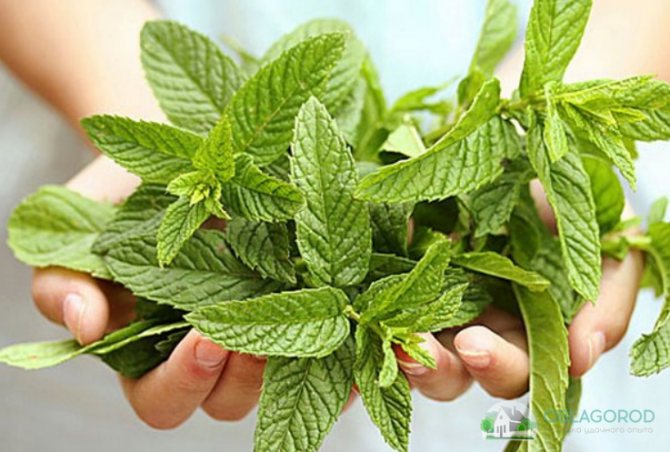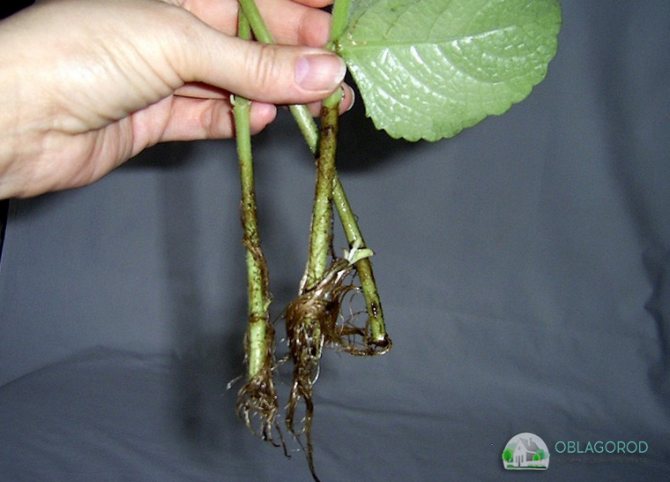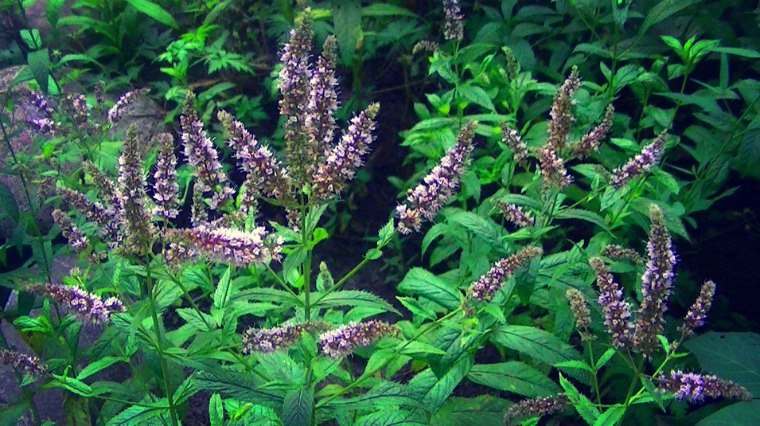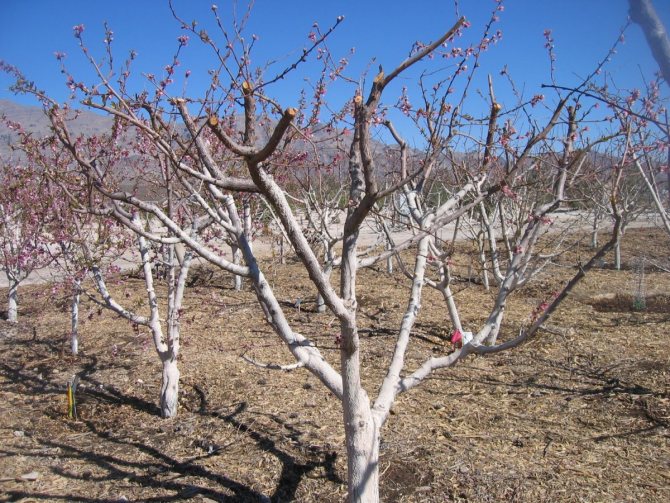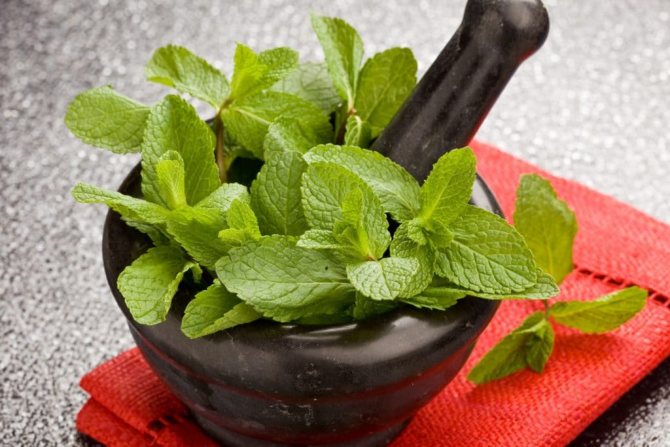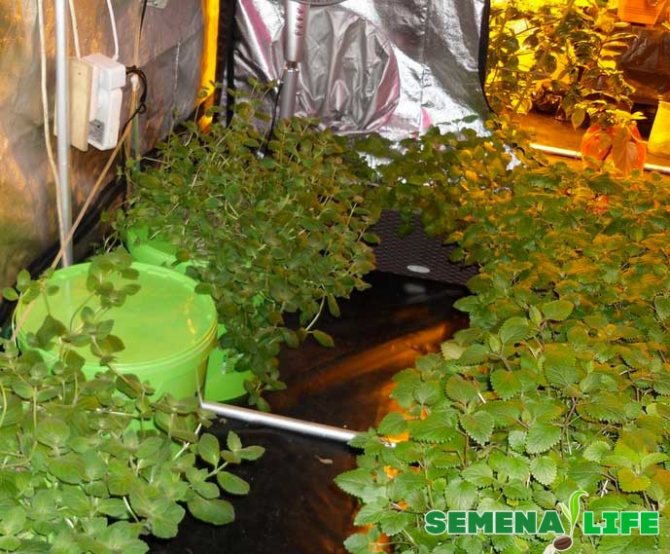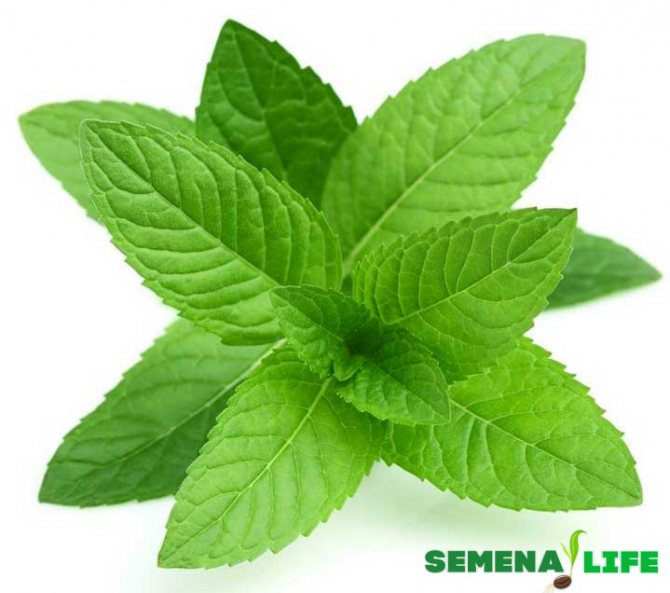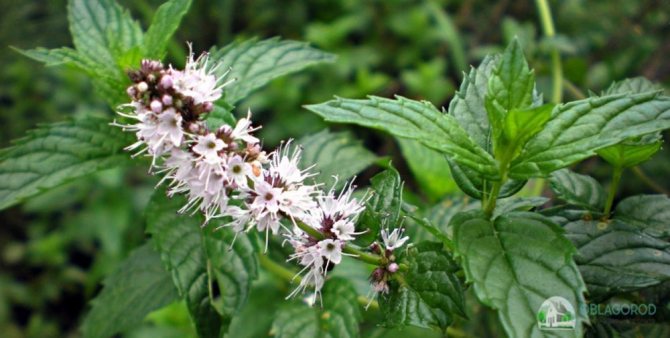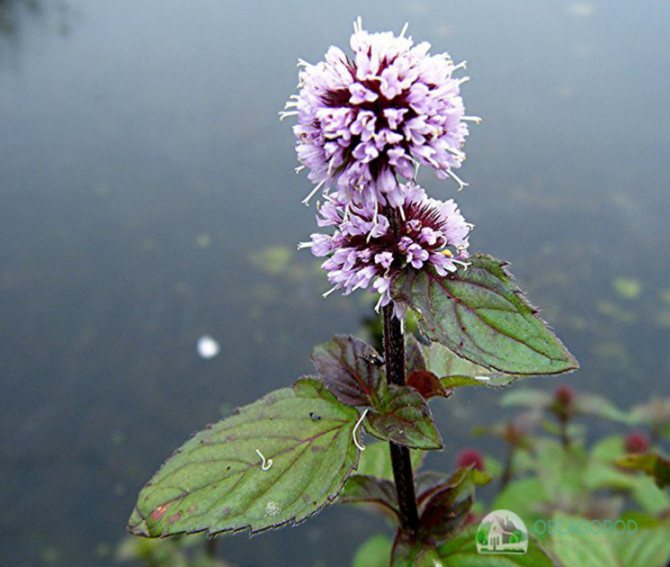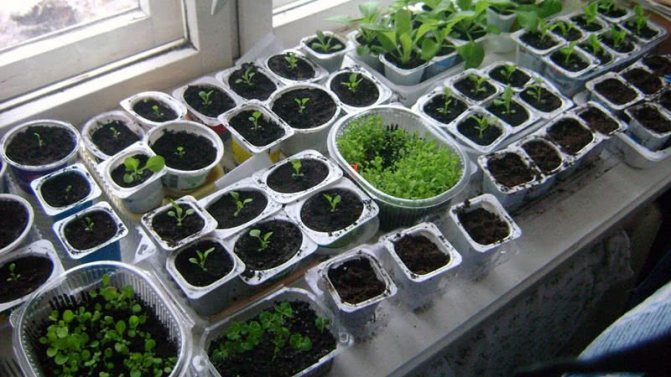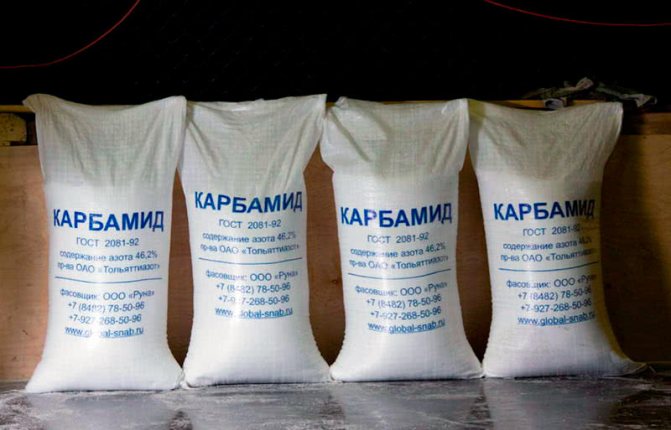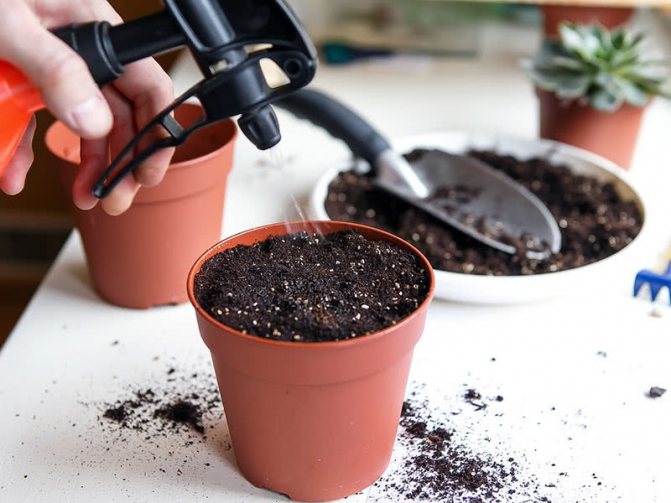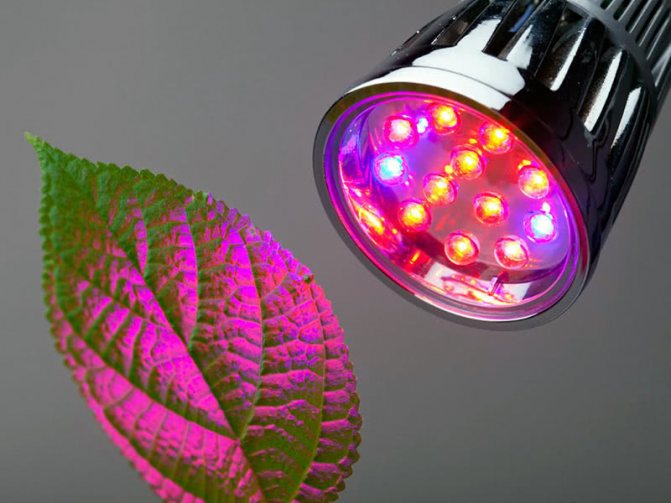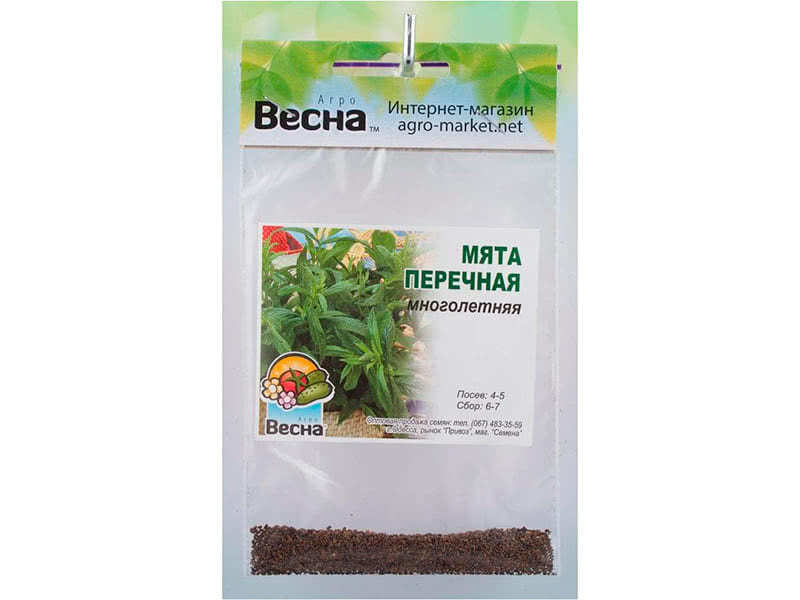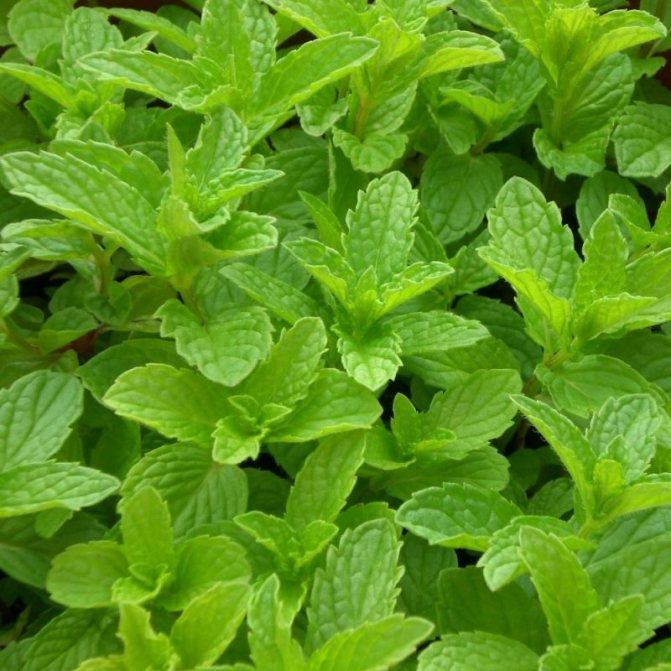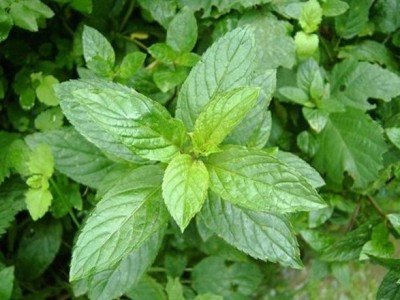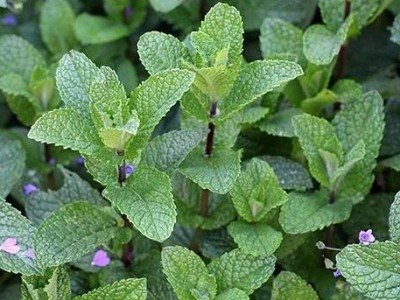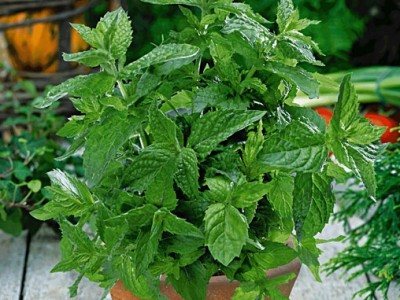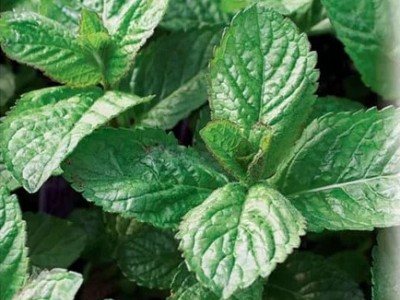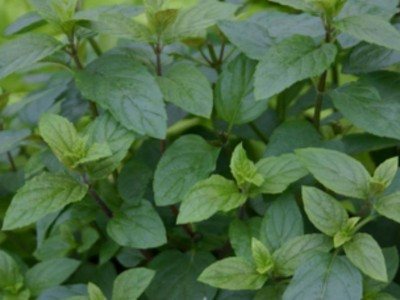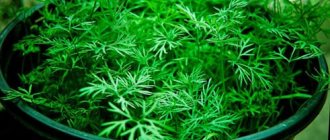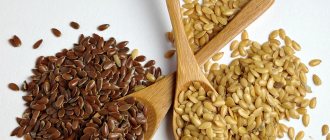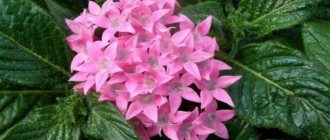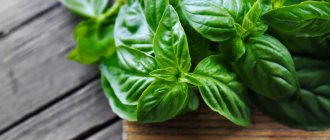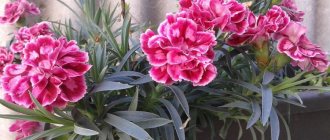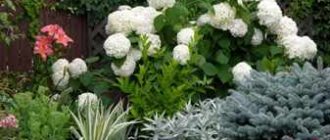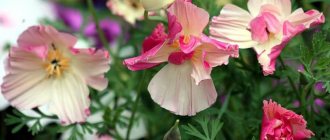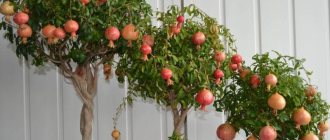Its aroma is one of the most recognizable and beloved, the leaves are present in the kitchen supplies of almost every housewife, and its natural properties help relieve nervous tension and restore a healthy sound sleep.
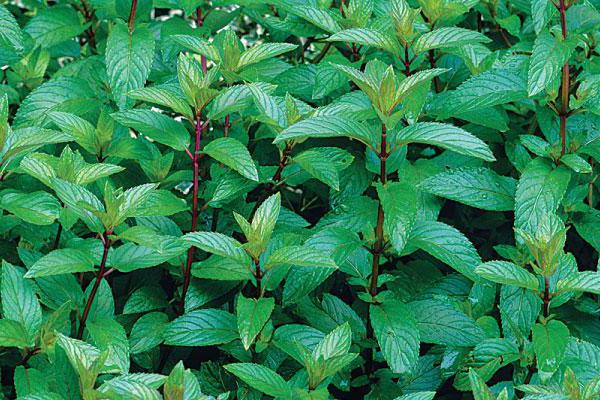
Mint is a herb that has earned the respect of culinary craftsmen and experts in traditional medicine. How to grow mint at home yourself?
Characterized by jagged leaves and tiny pink, purple, white flowers, the perennial is widespread in the wild and cultivated horticulture. At home, mint is a completely non-capricious and easily adaptable plant.
Vegetative growing method
How to grow mint at home? The most common method of propagation is vegetative, in which cuttings or rhizome cuttings with shoots can be used.
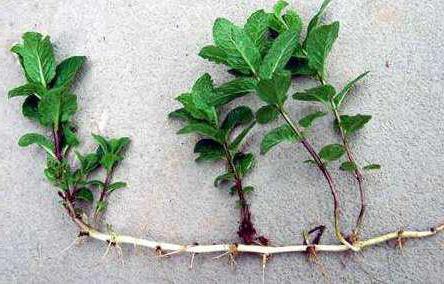

To obtain a cutting in the summer from an adult plant, you should cut off a twig with leaf nodules and place it in a glass of water or in the sand. Within a week, you can see the appearance of small white roots. When they reach a decent length, the plant can be planted in a permanent place of growth. You can also get planting material by digging a mint bush in early autumn and dividing it into several parts. Each of them should have shoots with roots and several buds.
How to choose quality planting material
Planting material for planting mint can be obtained in various ways - buy it in a store or nursery, order online, make it yourself (if you are already growing this plant), or ask trusted friends. Each of these methods has its own advantages and disadvantages, the final decision depends on many factors.
Self-collection of seeds from the mother plant is a rather painstaking and complicated process. In addition, artificially created mint varieties often produce seeds from which not a mother plant grows, but a completely different variety - from those used by breeders to breed a hybrid.
First of all, this danger relates to peppermint, which, as you know, is the most popular among gardeners. Of the curly mint seeds, about two-thirds do not inherit curliness and are a common wild variety.
Therefore, it is recommended to buy seeds for planting mint in specialized stores (it is better, of course, for the manufacturer to be reliable and proven), such seeds give stronger and more friendly shoots.
Mint does not reproduce well by seeds, therefore it is better to leave this matter to experienced gardeners. It is much easier to purchase ready-made mint seedlings, especially since there are many options for this.
Specialized store - a place where, as a rule, several varieties of seedlings are presented, from which you can choose a plant to your taste. The same applies to farmer markets, however, purchasing seedlings from unverified breeders is dangerous because the plants can be infected with pests or diseases, which can subsequently not only destroy the seedlings, but also cause serious harm to other inhabitants of the garden plot.
As a material for future seedlings, you can use an ordinary shoot from an adult plant, which is available in your neighbor's country house or in a friend's pot. To do this, cut off the sprout with a sharp knife or scissors at a height of 1 cm from the junction with the trunk of the mother plant. This sprout is placed in a glass of water, and when the white roots launched by it reach 5 cm in length, the seedlings are ready!
The same procedure can be done using mint, which is sold at grocery stores in supermarkets or in the market. This method does not guarantee a good result, but, in the absence of other options, it can be used as an experiment.
When choosing mint seedlings, you should pay attention to its appearance. Plants should not be lethargic, dried out, the height of the shoots should not exceed 6-8 cm, otherwise it will be difficult for the plant to take root.
Propagation of mint by seeds
The seed method is less in demand and is quite lengthy. Typically, mint seeds are purchased in stores. They need to be planted in containers with barely damp soil to a depth of no more than 0.5 cm, create greenhouse conditions for them, covered with plastic wrap or glass. After 7-16 days, the mint seeds will sprout; the emerging and matured seedlings should be transplanted into pots and determined in cooler conditions for the purpose of gradual acclimatization. After 7-10 days, the young plant will be ready to be assigned to a permanent place of growth.
How to grow lemon balm on a windowsill?
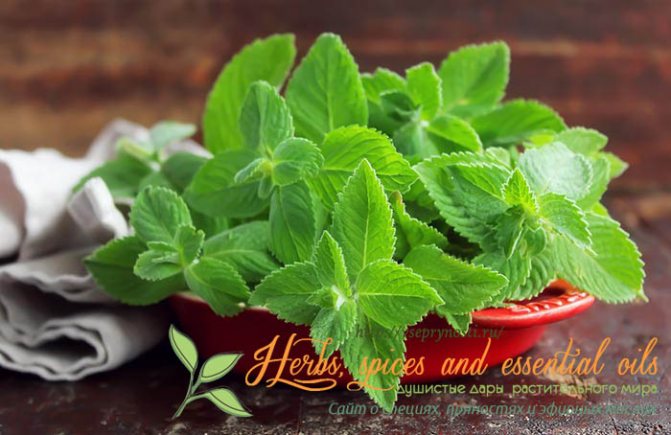

Seed growing method
To do this, plant the seeds in a box, which you must fill 2/3 of with soil mixture, which must be purchased at a special store.
- You can make such a soil mixture yourself. To do this, take in equal proportions ordinary turf soil, peat and humus. Mix thoroughly.
- Pour into containers prepared for planting, make grooves there 0.5 cm deep, at a distance of about 5-6 centimeters from one another. Pour water over them.
- Before planting, the seeds should be dry, sprinkle them sparsely, cover them with soil, water.
- Moisten the soil regularly before the first shoots appear.
- Seedlings should appear in about ten to fourteen days.
Reproduction method by cuttings (vegetative)
From absolutely identical to what is written above in relation to propagation by cuttings of mint.
Plant care
In winter, you should not leave lemon balm on the balcony, it is better to bring the flowerpots or boxes into the house and install them on the windowsill.
- At the same time, it is necessary to be careful not to overcool the plant with drafts, not to dry it out, since, as a rule, there are central heating batteries under the windowsill.
- During this period, the plant can do without moisture for a long time, but do not overdo it. You just need to slightly reduce the number and frequency of watering in comparison with the summer period.
Melissa thrives on the same soil for several years in a row, so it makes no sense to change the soil mixture every year or two.
- Be sure to keep the soil loose, loosen it periodically so that the plant breathes better.
- Remember that lemon balm is a fairly light-loving plant, so provide it with adequate sunlight.
- When grown in shade, the plant slows down the production of a sufficient amount of essential oil and loses its aromatic properties.
Growing seedlings at home
If you want to pre-grow lemon balm at home on a windowsill in order to then move it into the ground in the spring, after sowing the seeds, you can cover the soil with a film for faster first shoots.
- As soon as the first true shoots appear, dive the plant.
- It is necessary to plant lemon balm seedlings in the ground in the first decade of May, when all danger of frost has probably passed.
- Plant the plant at a distance of 40-60 centimeters from each other so that the bushes do not interfere with each other during growth.
Mint on the windowsill - Useful video
Be sure to watch this video, where Oktyabrina Ganechkina tells everything about growing aromatic herbs on the windowsill.
Collection, preparation, storage of mint and lemon balm.
The collected leaves must be laid out on a dry surface in a dark place, out of direct sunlight.
It is necessary to dry the leaves until they are absolutely brittle.
Raw materials are stored in paper or cloth bags, in a dry and cool place.
Carefully keep the moisture level during storage low. Otherwise, it will lead to damage to your blanks.
How to grow mint at home: useful tips
Mint can be grown both outdoors and as a pot plant. For indoor maintenance, in which the plant can be grown all year round, a drainage layer should be placed in the planting container, and a soil composition of 1 part humus and 2 parts of leafy soil should be used as a nutrient soil. Plant a new plant here.
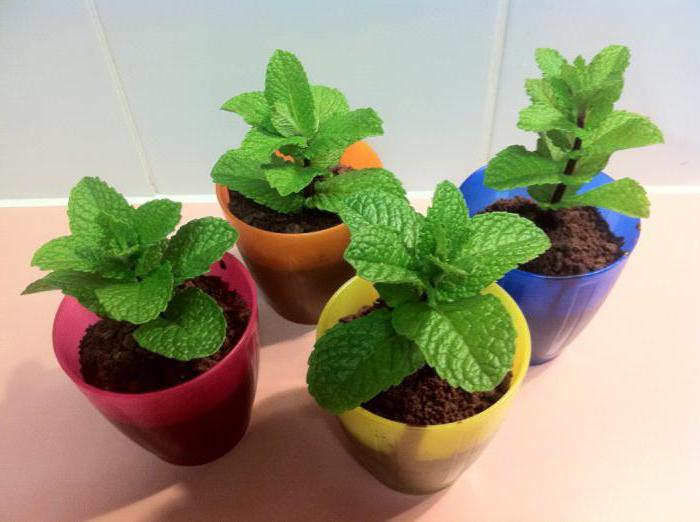

Mint on the windowsill will feel good in the west or east side of the room, without direct sunlight on the green leaves. In summer, the plant will be comfortable on the balcony, in winter - on a lighted windowsill. In room conditions, it should be controlled that the soil is constantly moist, and there is always water in the pan of the pot. Mint on the windowsill needs regular watering with soft water at room temperature, it is also recommended to spray the leaves from time to time. A weekly shower during the warmer months will only benefit a fragrant room culture. With regular cutting off of leaves, it is recommended to feed the plant once a month.
general information
Mint is a fragrant, gentle and refreshing herb that belongs to the Lamiaceae family. It is not demanding on the climate and the growing region, therefore it is grown by many gardeners in the country. But its widespread use in cooking leads to the need for many housewives to grow it at home.
Mint is widespread in different regions of our country, while it has more than 300 different species, but only 20-25 varieties are most widespread. Among them it is worth highlighting:
- long-leaved;
- spikelet;
- field;
- apple;
- water;
- green;
- curly.
1. Long-leaved 2. Spikelet 3. Field 4. Apple 5. Water 6. Green 7. Curly
Unlike other horticultural crops, this plant has a menthol refreshing scent that is slightly weaker in pepper than in other varieties. Depending on the variety, it can have a green or reddish-purple color of leaves and stems. In this case, cultivation can be carried out in different ways.
You can plant it both with the help of a cuttings and with seeds. At the same time, for growing at home, novice gardeners generally choose the first option, since it is easy to implement. The second method is more complicated, since the use of seeds to obtain seedlings is a laborious and time-consuming process.
Mint cuttings
But if all the requirements and recommendations are followed, any housewife, even a very busy one, will be able to grow viable seedlings at home. Mint is a fairly undemanding plant, so it does not need regular watering, feeding and replanting.
Mint from seeds hatch after a while - on average 1-2 weeks.When sowing a significant amount of seeds, plastic containers can be placed on top of each other, which will significantly reduce the space they occupy on the windowsill.
Growing mint on a windowsill
Growing mint will be more successful if the containers with the growth are placed on the windowsill. The plant is light-loving enough, so it should receive ultraviolet rays for at least 4 hours a day. To do this, it is best to place containers on windows that face northeast or west.
With a lack of sunlight when planting at home, the plant may simply die, but it is not recommended to allow direct sunlight to fall on the seedlings during the day. This can lead to burns on the leaves and complications of care.
If the plant grows poorly, you need to use additional lighting.
To do this, they need to be placed at a certain height, which will prevent burns, which is 50 cm.
After the seedlings are strong and strong, they can be planted in separate containers. To do this, you need to pick up plastic deep containers and bowls, and place them on a lighted windowsill. It is important to provide for good drainage in pots, which can be crushed stone or broken brick.
Rubble Broken brick
Fertile soil with an acid-base composition within 6-7 is suitable for transplantation, feeding is carried out with specialized fertilizers and preparations.
Mint, like lemon balm, is not a demanding plant, which is why its cultivation is so common at home. But to ensure good survival of seedlings and abundant growth, special care is required for it, which should include the main activities:
- Removal of weeds during periodic weeding and loosening of the soil in a pot or container for planting seedlings.
- Moderate watering, the frequency of which depends on temperature and humidity. For example, when grown in winter, the plant requires moderate watering, and in hot summer, abundant watering.
- Application of mineral fertilizers containing nitrogen and phosphorus, which help maintain vitality.
- A plant transplant, which is necessarily carried out once every two or three years. This procedure rejuvenates the plant and ensures good growth and development.
Planting mint requires careful adherence to all these care requirements at first, until the mint gets stronger and stronger. Subsequently, she ceases to require such attentive care.
Growing mint seeds at home is not difficult. But in order to obtain viable seedlings, it is important to comply with all the basic requirements for planting and care.
- Before planting mint, you need to decide on the planting site: be it a flower pot or open ground.
- Mint is a plant that requires good lighting, moderate moisture and high-quality soil composition. It is also best to avoid drafts and choose a location that is sheltered from the winds.
- The plant prefers fertile and loose soil. The most optimal are fertile chernozem in the floodplain of the reservoir. But heavy clay soil, with a constant stagnation of moisture, will not be suitable for growing mint. Calcareous soils also negatively affect the intensity of the mint aroma.
- You can plant mint in open areas in spring, summer and autumn. In areas with cold winters, mint is planted in the spring (April-May) so that its buds, which germinate already at 2-3 ° C, are not damaged by frost. In the southern lane, on the contrary, autumn planting is recommended.
- When choosing a planting site, it is important to consider the degree of growth of mint, which may well displace other cultivated plants.
- So, having chosen an open sunny site for planting mint, it is necessary to clean it of weeds, loosen it and add, if necessary, organic (3 kg of humus per 1 m2) and mineral fertilizers (superphosphate, ammonium nitrate and potassium chloride, 15 g per 1 m2 ). For the prevention or destruction of pests, the ground is pre-watered with a solution of potassium permanganate.
- The best predecessors of mint will be vegetables, legumes, perennial grasses, fertilized, in due time, with organic matter (manure, compost).
- A ready-made germinated seedling is planted in a pot or grown directly from seeds. It is easier to plant pre-prepared mint seedlings. Planting is carried out in spring or autumn.
- A layer of drainage is laid out at the bottom of the flowerpot to prevent the roots from excess moisture. As with any other flower plant, there are holes at the bottom of the pot through which excess moisture will drain into the pan.
- It should be noted that clay pots help the soil dry out more quickly. And in winter, in a heated room, dry air will dry out the soil in the pot even more. Therefore, most often, plastic pots or containers are used for planting mint. The diameter of the pot should be at least 30 cm, taking into account the subsequent growth of the plant.
- Growing mint at home, you need to monitor the temperature in the room. A bright, warm place will have a beneficial effect on the growth and development of a perennial. If it is too cold near the window, you need to find a more suitable and comfortable place for mint.
- In dry air conditions, mint will “delight” with a moist “shower” from a spray bottle. But with a lack of light, the content of essential oils in mint leaves decreases, the aroma weakens and the stems, stretching out, may even die.
- The soil for the pot must be selected fertile, it is possible to combine the soil with fertile compost. Peat-based mixtures are also great. After filling a third of the pot with the prepared mixture, put the seedling in the pot and add the remaining soil mixture. Special flower supports can be used to support the planted process.
- With the seed method, after the appearance of dense shoots, some of them can be moved to another container. However, when extracting plants, you should be extremely careful, since the root system of young mint is still very delicate.
We suggest you familiarize yourself with: How to properly dry pumpkin seeds
Growing mint by the potting method, more often they still use seed sowing. Thus, young and fresh shoots of fragrant mint will appear on the windowsill and will delight you all year round.
Mint takes root very well and can be grown at home throughout the year. In summer, it is better to put the pots on the balcony, avoiding direct burning sunlight. In winter, pots look spectacular on a well-lit windowsill.
For culinary purposes, curly mint is more often chosen, due to the lack of a cold menthol taste in it, as in peppermint.
Apple mint, possessing a delicate taste and aroma, does not give a bitter taste when heated, therefore it is added to compotes, jam and jelly.
Field mint is an excellent aroma addition to tonic drinks.
- The technology of planting mint on a personal plot does not differ much from growing it on a windowsill. Having prepared the soil accordingly, as indicated above, you can proceed directly to planting.
- Mint is planted in furrows up to 10 cm deep, maintaining a distance between rows of at least 40 cm, and between plants in a row about 30-40 cm. After sprinkling the shoots with earth, the beds should be watered.
- In order for the plant to bush better, at a height of about 20-25 cm, pinch the upper parts of the shoots. By continually removing the mint flowers, you can maximize leaf growth for later harvest.
In one place mint is grown from 3 to 5 years, then, in order to improve and rejuvenate the plant, it is better to change the bed.
If you are going to grow mint in your personal plot, you need to remember about its ability to actively grow. Creeping rhizomes quickly and aggressively occupy new spaces around. To avoid such overgrowth, you can initially protect its root system by burying restrictive strips of iron, plastic or slate to the depth of the rhizomes.
Mint is a relatively unpretentious plant that grows and reproduces on its own in a garden bed.
- When planting and caring for mint, it must be borne in mind that this perennial is a moisture-loving and light-loving plant. Watering is needed moderate, avoiding waterlogging and drought.
- When caring for the plant, it is enough to weed out the weeds, loosen the soil and water as needed. The soil should be light and crumbly.
- To obtain a greater green mass, in the spring, as the shoots grow, it is recommended to carry out a strong pruning - the mint will bush better.
- Spring top dressing with complex fertilizers (humus, nitrogen-phosphorus mineral dressing, potassium salt) will only improve the growth and development of the plant.
- Mint can grow optimally on sandy loam and loamy soil with sufficient humus and moisture content. The plant does not tolerate waterlogging.
- In frosty and little snowy winters, you can cover the mint with dry foliage, sawdust or spruce branches with a layer of 15-20 cm. Such measures will prevent the plant from freezing.
Mint: outdoor growing conditions
When grown outdoors, mint should be placed in a sunny location in fertile, well-drained soil. The best precursors for mint are turnips, carrots, and potatoes. The planting depth of the seedling is 10-12 cm, the recommended distance between plants is 15-30 cm. The shrub will root better if, when planting at a distance of 5 cm from the soil surface, its aboveground part is cut off.
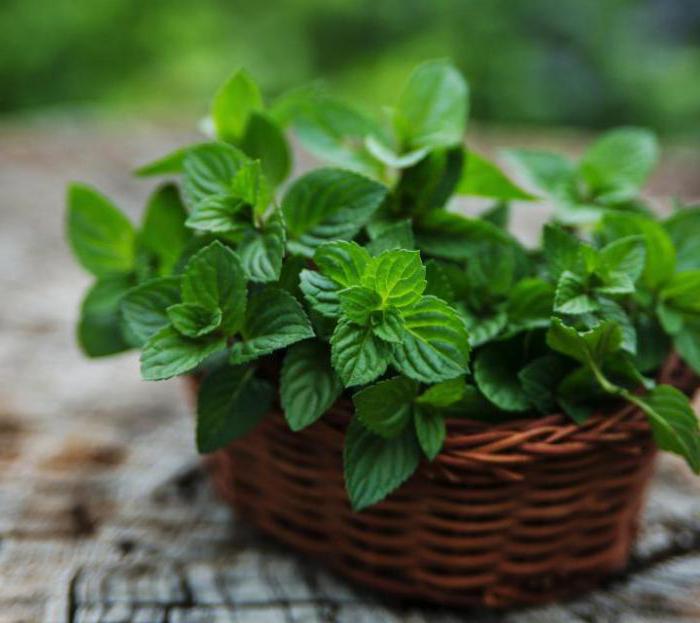

How to grow mint at home so that its reserves are not depleted? Mint tends to grow strongly. You can limit it in active growth to the sides by planting a bush in a wide container, which you can immerse in the ground. The planted plant will delight with young leaves in a couple of weeks. The top of the fragrant grass should be kept trimmed: this inhibits growth in height, causes overgrowth to the sides, thereby increasing the yield.
After planting, you can feed the mint with a urea solution at the rate of 2 grams of the drug per 1 liter of water. It is not recommended to fertilize the plant with nitrogen-containing agents: they will cause an active growth of the vegetative mass, which will negatively affect the accumulation of essential oils mint.
Why is mint dangerous in the garden
Mint is an excellent honey plant and has phytoncidal properties, which makes it particularly attractive to grow. However, if you decide to plant mint in your garden, you should be aware of the serious danger that an inexperienced beginner may face.
Important! Mint tends to grow very quickly throughout the site, its root system, like a cobweb, tightens the entire space so that this perennial plant can be removed only by radical deep digging.
If you do not forget about it before planting mint, such problems can be avoided. Some gardeners advise, when planting mint in open ground, to pre-protect the area selected for it on all sides, digging deeper into sheets of slate, metal or other improvised material that prevents the spread of the plant in width.
A more effective option is to use a special container for planting mint (a flower pot, a plastic bucket or an ordinary basin), which, together with the planted mint, is dug into the ground so that its rim slightly rises above the ground, but the roots of the plant were reliably protected from the possibility of growing ...
Mint is not a whimsical plant, it is enough just to make sure that it does not dry out and does not become overgrown with weeds. It is also important to loosen, huddle and periodically feed the soil, especially in early spring.
Mint grows and bushes better if the plant is cut radically at the beginning of the season.
To protect it from freezing, the mint bed should be covered with spruce branches, manure, straw, dry leaves, or simply sprinkled with earth.
In one place, mint can grow up to ten years, but periodically, once every 3-4 years, the plants need to be completely renewed, otherwise its root system is destroyed under the influence of weeds, and the mint becomes weak.
Harvesting and storage
Harvesting can begin in the second year after planting: about 3 cuts are made per season. It is best to harvest mint leaves during flowering (June – September) - it is at this moment that it has the highest content of essential oils.
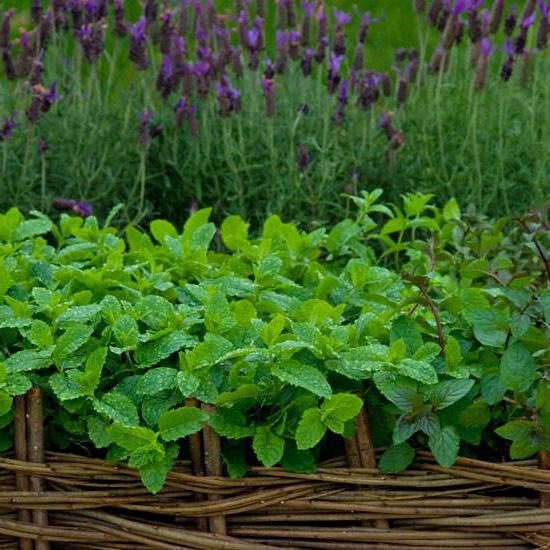

Dried leaves and petioles, which are the aromatic component of herbal tea and seasoning for dishes, should be stored in a dark place in a glass container. It is recommended to grow a garden culture in one place for no more than 4 years.
Planting dates for mint
Mint is a frost-resistant plant. It is allowed to plant in early spring and even late autumn. The main thing is that each season requires a specific planting method:
- The plant should be planted with seeds in early spring. Over the summer, it takes root and endures bad weather.
- In the summer they are planted with cuttings.
- Autumn transplantation is carried out only by cuttings. To prepare the plant for winter, the soil is mulched. Sawdust or peat are suitable as mulch. The layer should be thick, at least 15 centimeters.
The latest way that a plant can be propagated is by dividing the bush. Planting is possible even a few days before the onset of frost.
Home-grown mint varieties
On your own plot, you can plant several types of mint, or stop at one of them.
So, apple mint, characterized by a pleasant aroma and delicate refreshing taste, does not give bitterness and is tasty in compotes, jelly, jams. For culinary purposes, the entire aerial part of the plant is used. Green and variegated varieties, combining spicy and tasteful qualities with decorativeness, are characterized by wide ovoid leaves with a clearly visible thick pile. The height of the herbaceous bushes is about 70 cm.
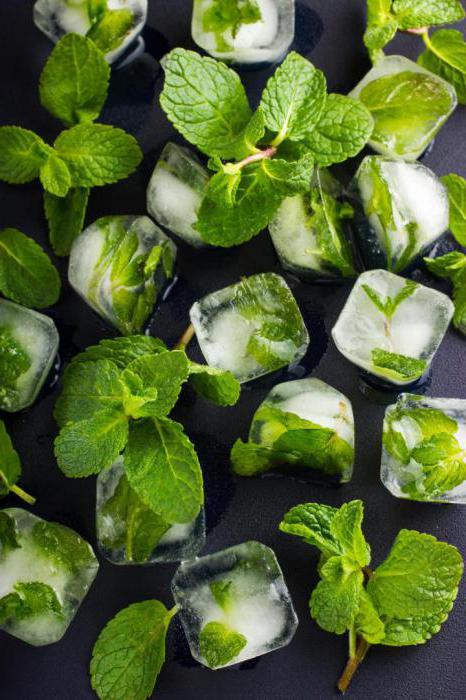

Curly mint is ideal for culinary purposes because it does not have the cold menthol flavor that peppermint has. The plant is characterized by strong stems and bright green, jagged leaves along the edges. Mint looks very nice in a pot, giving a year-round harvest when grown indoors.
Field mint fully reveals its qualities in tonic drinks. The long-leaved species contains a large amount of vitamin C and, due to the high content of essential oils, is successfully used in cosmetology and home soap making. Therefore, you should definitely acquire such a healthy culture on your own site, which is at the same time a medicine, a spice and a seasoning.
In cultural gardening, peppermint is widespread - a plant with creeping long roots, numerous branches with green egg-shaped leaves and miniature purple-pink inflorescences. Due to the high content of menthol, the aerial part of the grass emits a strong aroma and is characterized by a specific "cooling" taste.
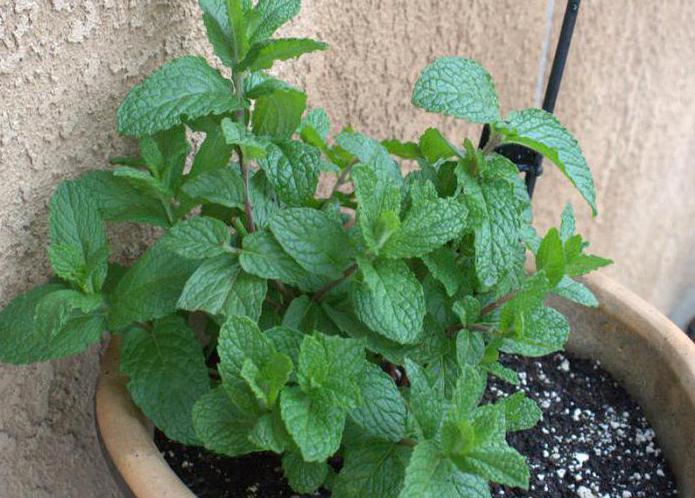

Young mint greens are used to flavor drinks, sauces, desserts, fruit and vegetable dishes. Peppermint, which has sedative and antiseptic properties, is a constituent of many medicines, is effective in treating colds and improves digestion.
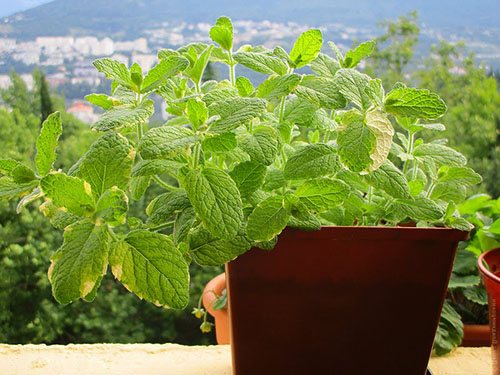

Mint and its closest related species, known as essential oil, spice and flavoring and medicinal crops, have long found their place in garden beds and gardens.But if during the summer the plants are regularly supplied with fresh greens, then with the arrival of autumn frosts, the gardener has to be content with frozen or dried mint in advance. And although these methods allow the plant to preserve most of the nutrients, such raw materials cannot be compared with green juicy leaves.
In order not to depend on the season and not to give up mint greens containing menthol, vitamins, valuable acids and trace elements, when it is frosty outside and a blizzard is raging, you can plant mint on the windowsill.
Beneficial features
Since ancient times, mankind has known the healing properties of mint. There are no significant contraindications for the use of mint. But every person is different, so excessive consumption of mint can cause side effects. Therefore, it is recommended to consult a doctor before use. Peppermint is a potent diuretic, which can lead to severe dehydration when taken in excessive amounts of this crop. But, in moderate proportions, mint tea perfectly cleanses the body of various unfavorable substances. Mint has a sedative and anti-inflammatory effect, relieves nausea and vomiting, and helps with severe headaches. Mint is used not only to decorate various dishes and drinks, but also widely and actively used in cosmetology in the preparation of essential oils, various ointments, shampoos and creams.
How to grow mint at home?
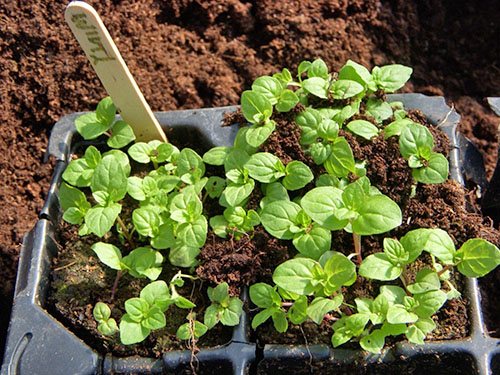

A perennial with a branched surface rhizome and many shoots extending from it can be easily grown at home. The main thing is to provide the plants with comfortable conditions, including adequate nutrition, lighting and watering.
Mint feels best on loose soils with an average organic content and low acidity, in the range of 5-7 pH.
Before planting mint for plants, a soil mixture is prepared from two parts of garden soil, one part of humus, the same volume of peat and washed sand. To prevent the mint roots from getting wet, and there is no danger of decay, drainage must be done in a container for growing mint at home.
Since mint is quite unpretentious, you can propagate the plant:
- sowing seeds;
- root layers;
- cuttings;
- dividing an adult bush.
Planting mint seedlings
You can grow a fragrant culture both at home and in the open field. Each method has its own characteristics and planting technologies.
Growing at home
Before planting mint seedlings, it is necessary to prepare a container where the plant will grow under constant conditions. To do this, you can use flower pots, which are equipped with special holes for removing excess moisture. You also need to remember about the drainage itself. Expanded clay, broken brick, pebbles and other materials that absorb moisture well can be used as drainage. For planting seedlings, a fertile soil mixture should be used. You can buy such a versatile soil or prepare it yourself. After planting the seedlings, the container with the plant is installed on the windowsill from the sunny side, and if summer comes, then the pots can be placed on the balcony. Watering the plant is necessary as the soil dries out. In dry indoor air, it is recommended to spray the plant with a sprayer.
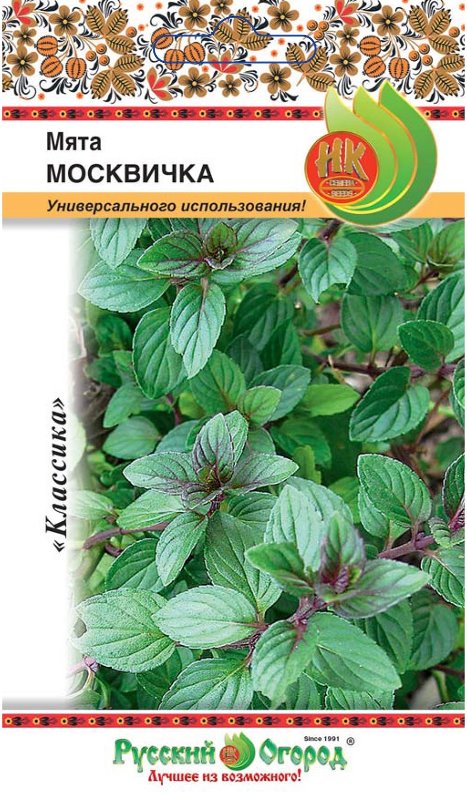

Growing in beds
Mint is practically an unpretentious plant. Growing crops in the open field does not present additional problems. But, for this you need to take care of the correct planting technology. Before planting seedlings in a permanent place, you need to choose the right site for growing a crop. Mint grows well in calm and well-lit areas. The soil must be fertile, so just before planting it can be additionally fertilized.Mint is planted in pre-prepared holes or trenches, the depth of which should be no more than 10 centimeters with a distance between bushes from 30 to 40 centimeters and a row spacing of at least 40 centimeters. The planted seedlings are sprinkled with soil, after which they are watered abundantly with water. For lush shrubs, the plant can be pinned when it reaches a height of 25 centimeters. To ensure maximum foliage growth, you must regularly remove the inflorescences from the plant.
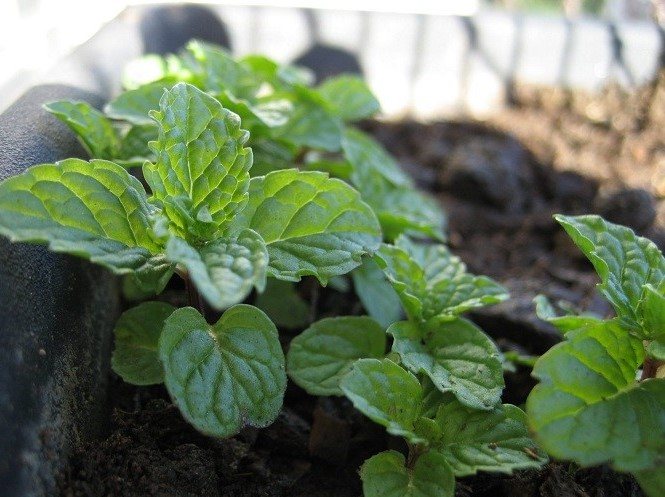

In a permanent place, mint can be grown for 3 to 5 years, and after this period, the plant can be transplanted. Thus, the bushes can be healed and rejuvenated. Before growing mint in the country, it is important to remember that this plant has an active rhizome, which constantly branches. To prevent the active branching of the roots of the plant, sheets of iron, pieces of slate or plastic are buried in the provided place.
How to grow mint from seeds on a windowsill?
Seed propagation is the most laborious and time-consuming method, but it cannot be avoided if you want to get a plant of a certain variety or type.
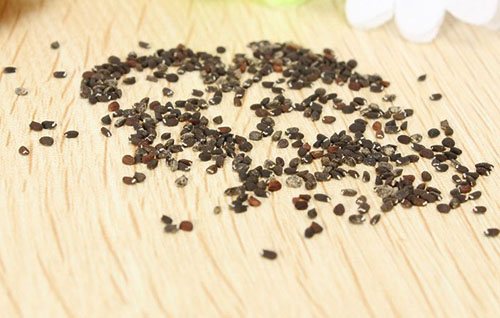

In order for the seedlings to be strong and friendly, it is better to give preference to purchased seeds. Not all hybrid species inherit the parental characteristics when collecting seed from them. So, for example, only a third of curly mint seedlings have curly foliage, and the rest of the seedlings are a simple garden variety. So how to plant mint seeds?
It is better to sow mint in March or April, in moistened soil to a depth of 0.5 cm. Sprinkle the seeds on top with a small amount of humus or nutrient soil and cover with glass or film. At room temperature, seedlings appear 14-18 days after sowing. Until this moment, it is necessary to monitor the moisture content of the soil, to prevent it from drying out or waterlogging. If necessary, the surface of the soil is carefully sprayed, trying not to disturb the small seeds, and the glass is slightly opened for ventilation.
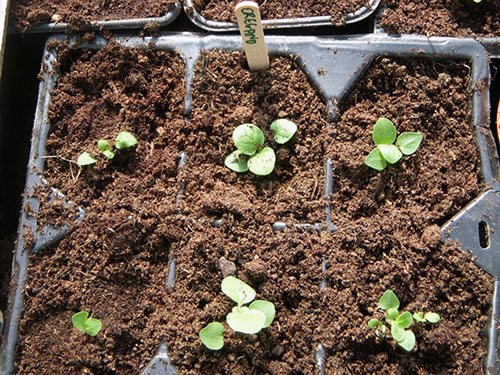

When the sprouts of mint on the windowsill give two true leaves, they are dived, seated in separate small containers or in a 5x5 pattern in a single wide container.
Your personal gardening consultant!
On a summer evening, sitting comfortably in a sun lounger, it is pleasant to have a cup of tea flavored with green leaves of fragrant mint. Such a pastime is not only pleasant, but also useful in terms of maintaining your health at the proper level. Although, why are we talking about summer? After all, you can enjoy this noble drink anywhere, at any time of the year, whenever you wish. And you need only one thing for this - to have fresh mint at your disposal all year round.
The statement is interesting, but where can you find mint leaves in winter, on snowy ground? But you don't have to look for anything if the fragrant plant grows in a pot on the windowsill. And in order for it to grow, you just need to navigate a little in the question of how to grow mint at home in the winter. And why not? If in "wild" conditions mint grows, then in greenhouses it will grow even more so. Competently select all the necessary components, observe the conditions that are responsible for its correct growth - these are all the requirements of home growing. Now everything said in detail and in stages.
What is mint grown from?
There are two ways to breed mint indoors. The first way is from seeds. Simple in essence, but requiring some knowledge of the "mint" varieties. Since the seeds will be purchased, you should initially know what to buy. Not knowing the grade, it's hard to get what you want.
The second method is growing from a cuttings.On the one hand, the option is troublesome, planting material needs to be harvested, but on the other hand, we will get mint faster, because nothing is germinated, but only grown and the variety will be what we want. We take the cuttings from the plant that we see and which we have tasted.
How to plant seeds
Consider how to grow mint on a windowsill from the most convenient planting material - from seeds. The procedure is simple. Purchased or personally collected seeds are taken, laid out in pits or grooves. To make it less work, and it will be more convenient, you can gently press the seeds into the soil, instead of spreading them out, and then covering them with an additional layer. Planting depth 0.5 centimeters. For the full germination of planting material on the windowsill, special conditions are not required. A normal room temperature of 20-25 ° C and moist soil are sufficient.
The next method to grow mint at home quickly and efficiently is cuttings and roots. It will be possible to indulge in fragrant tea in two to three weeks. But first, prepare the material. For breeding mint at home on the windowsill, you can choose either the upper cuttings or the lower ones. In the first case, the top of the plant is cut off by 8-10 centimeters. In the second case, a part of the rhizome is taken for the "seedling". Or the whole root if it is small. Cuttings from the top of the mint are pre-germinated in a container with water or wet sand. After the emergence of young roots, they are transferred to a separate container (pot, box) for further growth. Cuttings from the root system are planted directly into prepared, well-moistened soil. Everything else is the same as with seeds, but it is not necessary to cover the "bed".
Soil and container - the right choice
For planting mint seeds, it is recommended to take one large box, the size of the windowsill. First, all planting material is planted in one container. After the first greenery appears, each plant is transplanted into an individual pot. But if desired or necessary, everything can be left as it is, removing the most frail plants from the general growth and planting healthy ones from one another at a distance of 5 centimeters. For cuttings, the pots are used immediately. No plant transplant is foreseen here.
On the ground. Mint loves fertile, loose soil. To grow mint at home on a windowsill in winter, you can use ordinary garden, well-fertilized soil. It's not bad if it is mixed with sand. A good option is peat soil. On it, mint also gives an excellent harvest. In the case when there is neither one nor the other, garden soil (2 parts) is taken and mixed with humus (1 part). And the last is the purchased substrate. Ideal for city dwellers.
When filling the containers with the prepared substrate, do not forget about creating a drainage layer at the bottom of the pots or box. A layer of two to three centimeters of expanded clay or fine gravel will be enough to remove excess water from the soil.
Providing optimal conditions for growing mint in the window
Lighting
The place where the pot with the planted seeds or cuttings will stand should be light, but without direct sunlight. Penumbra will also be good.
Depends on the illumination of the "vegetable garden". 20-25 ° C heat without drafts is just the norm if the pots or boxes are in a well-lit place. When daylight is not enough, it is recommended to lower the room temperature to 15 ° C or put young greenery on a less heated balcony. In low light and high temperatures, the mint stalks will be thin, and the leaves will be defective.
Since growing mint at home can be done at different times of the year, watering the plant should also be different in intensity. In winter, the beds are watered sparingly, avoiding an excess of water and the formation of dirt. In summer, the regularity of watering is slightly increased due to the increased ambient temperature.But even relatively increased watering should not lead to the plant's root system being waterlogged.
Winter mint feeding is not required. Unless, feed the cuttings at the beginning of their vegetative period (when the first young shoots appear). For feeding, it is recommended to use a solution: 1 gram of urea per 1 liter of water. In the summer, it is allowed to apply mineral fertilizers, but in a sparing, safe amount for health and only at the stage of the appearance of the first leaves.
They planted, germinated, grown, harvested - easily, quickly, pleasantly. Mint is probably the only plant that grows and cares for at home brings real pleasure to gardeners. A beautiful view and a pleasant aroma in the room, in addition to the beneficial qualities that contribute to the prevention of a wide variety of diseases, make mint indispensable when there is a lack of truly fresh fragrant greens.
Share useful information:
How to plant mint by root layers and dividing the bush?
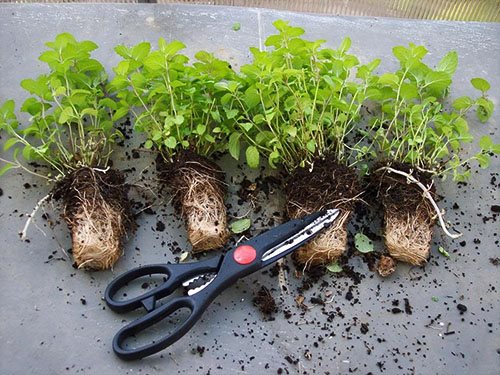

Gardeners and gardeners know how the mint that has taken root on the site quickly takes up new spaces. Long rhizomes with dormant buds are to blame for the predatory activity of the plant. The expanding root system of one plant gives life to new shoots and bushes. How to plant mint with root cuttings?
If you take advantage of this feature of mint, and in August or September stock up on root cuttings, about 10-12 cm long and two or three buds, then there will be no difficulty in the question of how to grow mint at home. Root layers are planted in moistened soil to a depth of 5–7 cm. If there are already developed shoots on such a cuttings, the roots are carefully preserved, and the aboveground part, after sprinkling with soil, is cut off at a height of 4–5 cm. The same is done with the planting material obtained after dividing the whole bush.
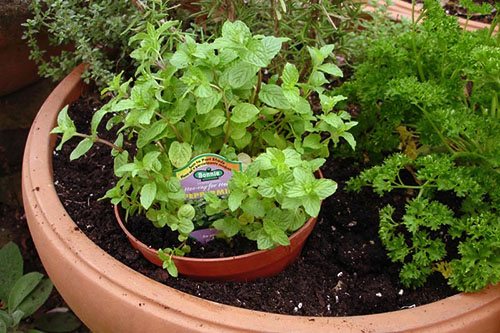

After two weeks, with proper care, indoor mint, as in the photo, forms dense green shoots and the first odorous leaves above the soil.
The same breeding methods are suitable for planting on the windowsill such herbs as oregano and thyme, which belong together with mint to the same family and have common habits and characteristics.
All of these crops are grown at home as perennials and require light but constant care.
Description
The fragrant herb mint is familiar to everyone. It is grown on a personal plot and at home. Mint leaves are widely used for medicinal purposes, as well as in cooking as a spice.
The aromatic herb has a strong root system that grows well, and the jagged leaves are bright green in color. The plant is unpretentious in care and can grow on the site along with weeds. The species diversity includes more than 100 species.
Mint should be grown separately from other crops, especially those for which chemical treatments are expected. The leaves and flowers of the fragrant plant are unusable after spraying. The rapid multiplication of mint bushes will displace neighboring crops from the site.
Growing mint at home using cuttings
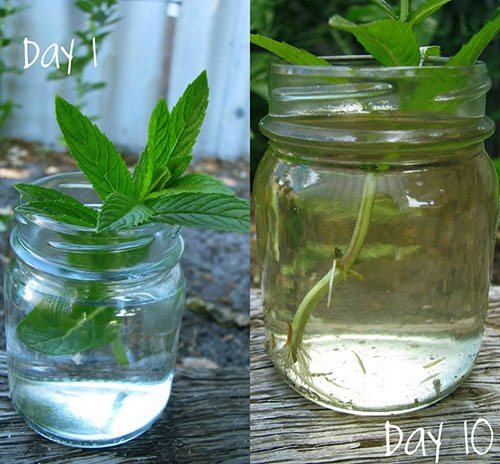

Cuttings cut from the tip of the shoots of an adult bush are also suitable as planting material for growing mint on the windowsill. How to grow mint on the windowsill in this case? Twigs 6–8 cm long are dipped in a root solution and, after removing the two lower leaves, are placed in water. Roots sufficient for planting in the ground are formed after 7-15 days.
Two weeks after planting the rooted cuttings and the appearance of shoots on the planted root processes, the plants are fed with urea at the rate of 1 gram per liter of water.
How to plant
You can plant mint with rhizome cuttings, seeds and seedlings. Seed propagation is thought to be difficult for beginners.In fact, planting is similar to planting any other greenery, and the most important thing in this process is the quality of the seeds. When purchasing seeds from the store, it is important to make sure they are fresh. Mint seeds are very small and are planted in bulk.
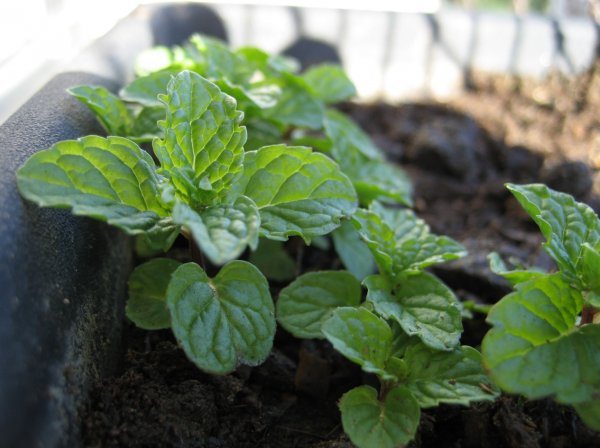

This herb can be planted in spring, late April or early May. Additional landings can be done at the end of summer. Mint is undemanding to the soil, but does not grow very well in dense, overly moist beds. When planting directly into the ground, you need to make grooves no more than 1 cm deep (optimally - half a centimeter), water them, cover the seeds and sprinkle them with earth.
You can choose a compromise option - sow seeds not in the ground, but in pots, grow seedlings and plant them in the country. You can sow seeds for seedlings in February. For this, shallow boxes are filled with nutritious light soil with an admixture of peat, watered and scattered seeds over the surface, slightly pressing them to the soil. After that, the box must be covered with foil (but not tightly so that ventilation is maintained) and put in a lighted place, but not on the windowsill.
Very small sprouts appear after twelve to fourteen days, after which the boxes can be put on the windowsill for hardening, but removed at night. After about two months, full-fledged bushes grow, which can be transferred to the garden. The advantage of growing mint from seeds is that these plants will produce tender, young greens.
Caring for mint grown on a windowsill
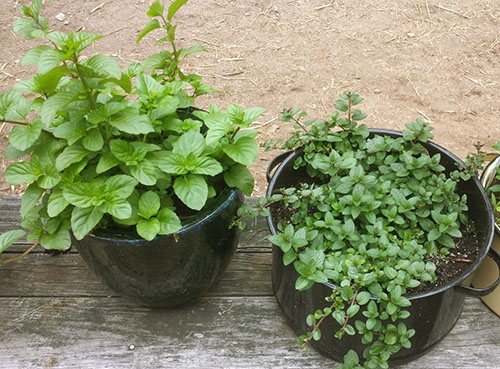

When wondering how to grow mint at home and get strong bushes with juicy bright foliage on the windowsill, it is important to remember that this is possible only if there is the correct temperature regime, watering and sufficient illumination.
The temperature comfortable for growth is 20–25 ° С. With this mode, long daylight hours and moist soil, plants form foliage well.
Mint reacts sensitively to changes in illumination, in room conditions, without additional 6-hour illumination in autumn and winter, its shoots begin to stretch, the leaves become smaller, lose their rich color and aroma. If it is impossible to organize the necessary artificial lighting of pots with mint on the windowsill, you can reduce the temperature to 15-17 ° C and limit watering. This measure will somewhat slow down the growth processes and will not allow the quality of greenery to decrease.
With all the love of mint for light, the plant does not tolerate being in the sun in direct sunlight. Mint placed on the balcony, terrace, loggia or on the windowsill must be shaded, protecting the planting from burns and drying out.
In rooms with a dry atmosphere, especially when heating devices are working, a container with water can be placed next to the mint so that the air humidity does not fall below 80%, which can adversely affect the condition of the bush. For the same purpose, for mint on summer days and in winter, in a warm room, irrigation is carried out with water at room temperature.
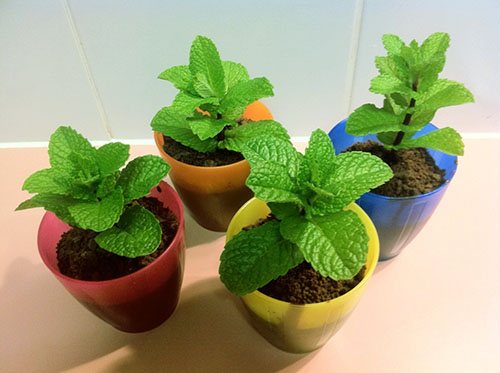

As well as excessive dryness of the air, mint on the windowsill also does not tolerate drying out of the soil. The soil is watered at the first signs of dryness of the upper layer, but at the same time they do not allow stagnation of moisture, which is detrimental to the roots. With a decrease in air temperature, the need for irrigation drops slightly.
To simplify the care, as in the photo, for room mint, a little hydrogel can be added to the soil for planting it. Several granules in the soil layer above the drain will allow the soil to retain moisture and fertilizer better.
Diseases and pests of mint
The main pests of young mint are mint flea, mint leaf beetle, aphids and mites.
To combat a flea that damages the leaves and roots of a plant, a mint bed in the fall, after harvesting, you can process a con (60 g per bucket of water). The leaf beetle is especially common in lowlands with an excess of dampness. It is difficult to deal with this pest, but you can create conditions in which it will feel uncomfortable - limit watering and increase ventilation.
Powdery mildew is a white, cobweb bloom that infects leaves. The onset of the disease can be avoided by not planting the mint too close to each other, and by regularly weeding the weeds. If the plant is affected, it should be sprayed with colloidal sulfur (one and a half percent solution with the addition of potash or green soap).
Mint is susceptible to a disease such as rust. The lesion begins at the roots and appears as orange spots on the inside of the leaf. Sick bushes should be disposed of without pity.
To combat powdery mildew and rust, it is necessary not only to collect, but also to burn all the affected leaves, since the infection is located in them. In the fall, the site should be deeply and thoroughly dug up.
Diseases and pests of mint should be fought with preventive methods, since the peculiarity of this plant is that almost any poisons make it completely unsuitable for eating fresh or for drying.
Tags: cultivation, mint, fresh, seed
About
«Previous post
Timing of collecting mint at home
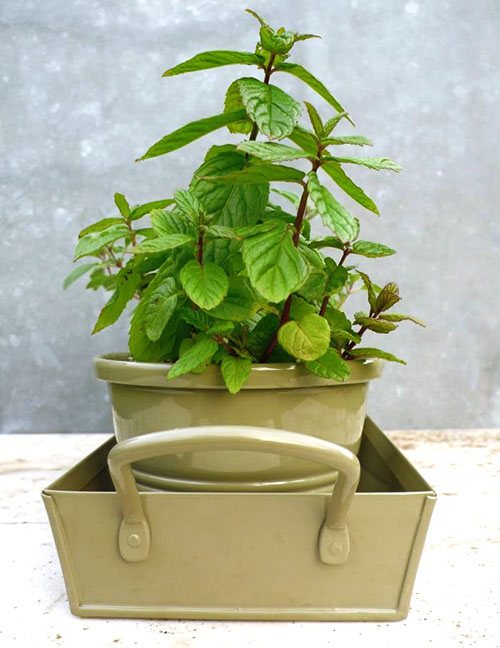

The first crop of home-grown mint is harvested within 15–20 days after the first leaves appear above the ground. By this time, mint bushes reach a height of 20-30 cm, while trimming the tops of the shoots leads to the awakening of the buds in the axils and the growth of the plant.
If mint is grown in order to obtain raw materials with the maximum content of useful essential oils, then the timing of mint harvesting falls on the moment of peduncle formation or the beginning of flowering. In this case, during the warm season, when growth is most active, you can get up to three full harvests.
Mint is a very healthy and aromatic plant. It is added to tea to calm the nerves, improve mood and tune in to a sweet dream. And if you just touch the mint leaves, the space will be filled with a wonderful aroma. Therefore, many people want to know if it is possible to grow mint on the windowsill (especially in winter), and how to do it. Naturally, for this you need to have information about the basic rules for planting and caring for a plant at home.
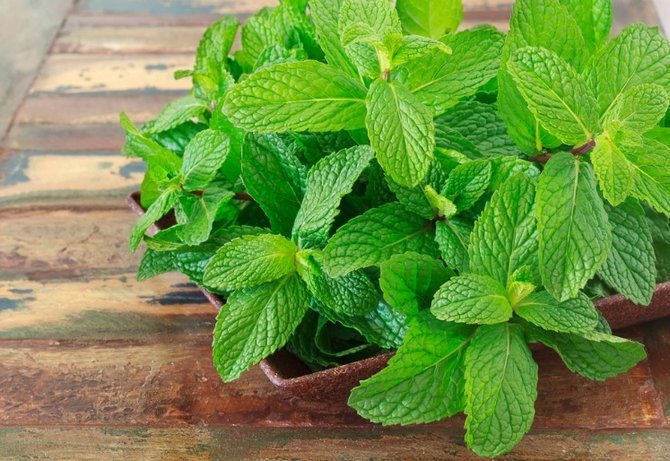

How to collect mint
The greens are cut as needed. To keep it fresh, keep it wrapped in a damp cloth or in the refrigerator in an airtight container. Collecting mint for drying is carried out on the eve of flowering or at the very beginning - it is then that a maximum of aromatic substances accumulates in the aerial part of the plant.
The stems are cut and dried in the shade, hanging the bunches with the inflorescences down. Leaves and inflorescences are valued as raw materials, which are cut off from dried stems and stored in a tightly closed container, in a dry, cool, dark place. The maximum storage period is no more than two years. Mint is an almost universal culinary flavoring.
The harvest of mint can be started 2-3 weeks after the first shoots appear. By this time, the plant reaches 20-30 cm, and excess pruning only enhances its growth and promotes branching.
If the purpose of harvesting mint is drying, it is better to wait until the plant is gaining the maximum amount of essential oil. This period coincides with the formation of honey plants and the beginning of flowering.
You can pick mint in different ways: pick off the leaves or cut off the entire stem.
For drying, the material is laid out on a flat surface in one layer and left to dry completely. After that, you can separate the leaves from the stems and grind them, you can leave them whole.
Mint is stored in closed vessels in a dark, dry and cool place, which allows it to preserve the menthol aroma until spring.
Self-grown mint is not only the best option for harvesting, but also a great reason to spend a summer evening with a cup of aromatic spicy tea, for the preparation of which it is enough to add a few freshly picked leaves from the home garden to the usual drink.
Was this helpful?
Thank you for your opinion!
Write in the comments which questions you have not received an answer to, we will definitely respond!
You can recommend the article to your friends!
You can recommend the article to your friends!
Yes
Not
223 times already helped
Features of growing mint on the windowsill and methods of reproduction
Growing mint at home on a windowsill is no longer considered some kind of exotic occupation. However, in order to grow a fragrant green plant at home, you need to take into account some features of planting and care, and most importantly, create suitable conditions (light and temperature).
There are several ways to grow homemade mint on the windowsill:
- If carried out sowing by seeds, then you need to be prepared for the fact that the seedlings sprout poorly and slowly.
- It is best to grow mint on a windowsill from cuttings, they take root faster and immediately begin to grow.


By the way! For grafting and growing at home, even the mint that you buy in the supermarket or in the market is suitable. The main thing is that it is fresh (be sure to look at the production date - cuttings and its appearance).
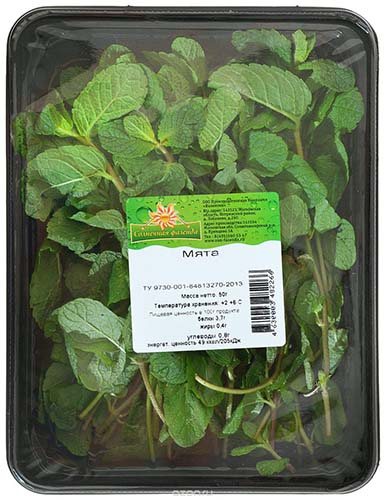

Video: how to grow mint at home in a few days
You can also just take and transplant mint from open ground into a pot.
Important! Many people face such a problem: after transplanting from the soil into a pot, the mint begins to dry, despite a sufficient amount of light, normal watering ...
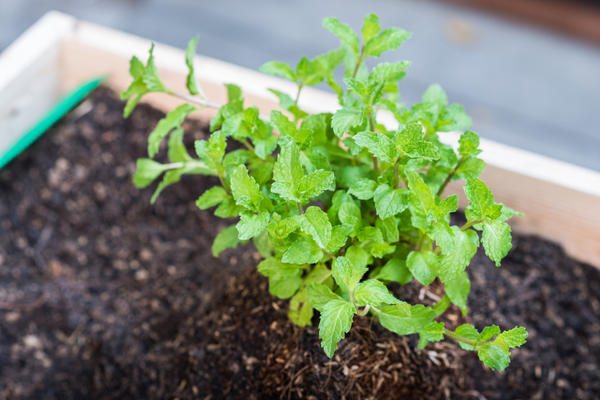

Interesting! At home, mint can grow for a very long time (10-20 years), and it will be the same plant. Naturally, it will grow over time, and when it becomes cramped in the pot, you can simply divide the ball into several parts. Extra bushes can be given to someone or simply thrown away.
Thus, growing mint on a windowsill is not too different from growing other plants indoors. The main ingredients for success are enough light, a comfortable temperature, and moderate watering.
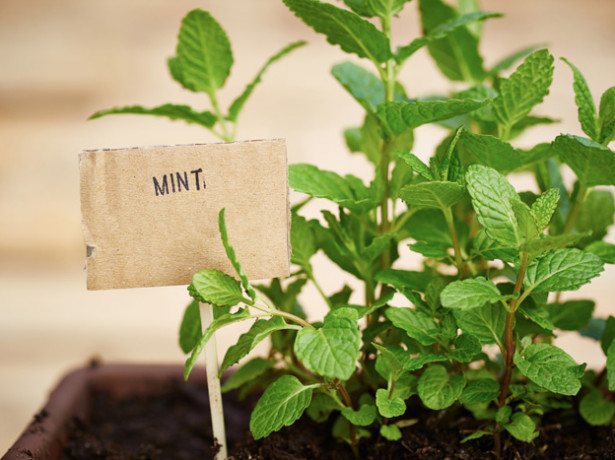

Video: features of growing mint on a windowsill
Note! Cats love to rummage around in containers of mint, so take care to protect the plants from pets!
Landing - step by step instructions
Mint is a frost-resistant plant, so it can be planted both in autumn and in spring or summer. Nevertheless, for each method of breeding mint, planting at one time or another is optimal.
Planting mint by sowing seeds in open ground should be done in early spring, since during the winter the seeds will simply freeze out. On the other hand, if you plant seeds in the summer, the seedlings of a perennial plant will not have time to take root and get stronger before the onset of the first cold weather.
The vegetative method of planting mint can also be carried out in the spring, but not early, but later, when the material for vegetation is fully ripe.
Planting of mint with stem and root cuttings is carried out at any time of the year - in spring, summer or autumn, depending on the climate. In the northern regions, planting of mint is still recommended to end in August, so that the plant has enough time for rooting.
In addition, with late planting, it is worth taking care of additional preparation of young mint for winter, in order to avoid freezing of the bushes - mulch the garden bed with a thick (up to 20 cm) layer of peat or sawdust.
This procedure is especially relevant in areas where winters are frosty and at the same time not snowy enough.
The latest of all possible breeding methods is the division of the bush, it can be done a few days before the first frost.
Growing mint using seeds is a long, laborious and complex process, since it requires increased attention, without which the seedlings can die.Also, the seeds do not guarantee full germination, therefore, even when using a whole bag of them, only a few seedlings can sprout.
Another factor that is important to consider when using this method is the fact that hybrid varieties, when propagated and grown by seed, can produce a plant that is different from the mother. Such varieties-hybrids include pepper, Dutch and others.
Dutch peppermint
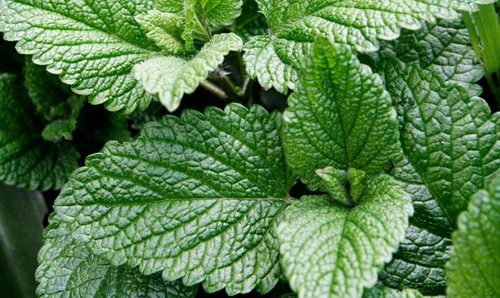

This method is preferable to use if planting is carried out in winter, and the seeds cannot be collected from the mother. In this case, a bag of planting material of a certain type (curly, peppery, lemon, long-leaved, and others) can be bought at a regular gardening store.
It is advisable to immediately take several, since when using them it is difficult to get good germination. Despite the fact that planting mint seeds is quite difficult, if you follow all the recommendations, rules and requirements of gardeners, you can get a good result. Mint seeds
So, how to grow mint at home. To do this, it is important to follow the steps:
- Since the size of the seeds is very small, the process of sowing them must be taken very carefully. If a seed hits the ground deeply, it will not be able to break through to the surface. That is why it is important to maintain the optimum planting depth, which is no more than 5 mm. The best time for this is early spring.
- For home sowing, it is better to choose a small, clean enamel dish. The best option is an ordinary plastic pallet, since it is quite easy to use, it is clearly visible even without the need to open the lid, and after transplanting the seedlings, you can simply throw it away.
- Mint of all varieties prefers fertile soil, which must be prepared in advance. For this, the land should be combined with humus, compost and wood ash. It is also possible to use a regular commercial one, which is suitable for vegetables or herbs. Moreover, if the earth contains a large amount of lime, then the mint aroma will not be so strong. This opportunity can be used by housewives with severe allergies.
- It is best to plant the seeds in a plastic container with a lid, as this will create an airtight environment and maintain an optimal temperature. When using plastic or iron enameled dishes, you will need to open the lid every day and view the state of the seedlings, moisture or dryness of the soil, and the transparent walls and lid of the container make it possible to do this without harming the seedlings.
- Favorable conditions for germination are a temperature of 21-24 degrees and optimal humidity conditions. Therefore, in winter, next to the seedlings, you can put a bowl of water, which will evaporate and humidify the surrounding air.
- Ventilation can be provided in plastic containers if required. To do this, small holes must be made on the walls and lid.
We suggest that you familiarize yourself with: What essential oils repel fleas
How to plant and grow mint on a windowsill - features, conditions and step-by-step instructions
To grow mint on the windowsill at home, you need to know how to germinate and plant cuttings, how deep the seeds should be (you should immediately say that you need to sow superficially), in what container and soil, and also the most important thing - under what conditions the mint will grow well.
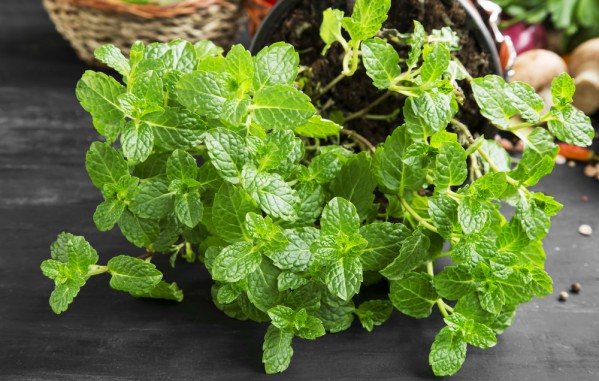

What should be the place for growing: the required illumination (daylight hours), temperature and humidity
Naturally, to grow mint in an apartment on a windowsill, you need a lot of light. Therefore, it is optimal to place the pot on the southern or southwestern (southeastern) windowsill.
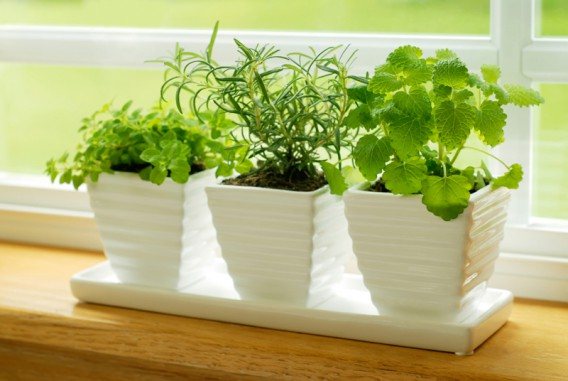

But it should be borne in mind that the summer midday sun rays can burn tender young leaves. Therefore, it is recommended to rearrange the pots to the west or east windows after lunch.If this is not possible, then the plant should be shaded or moved to the back of the room for a while.
Pay
Attention! If the mint on the window does not have enough light, the shoots will begin to stretch excessively, and the leaves will acquire a light shade and decrease in size.
Naturally, in late autumn, winter and early spring, mint grown indoors will have to be illuminated. To do this, you need special phytolamps or full-spectrum LED lamps.
The optimal temperature regime at which mint develops well is +20 .. + 25 degrees.
But, if you cannot give the plant a full daylight hours (12-16 hours), then the mint will begin to stretch. This can be compensated for by lowering the temperature to +15 .. + 18 degrees. This is especially true for the winter season.
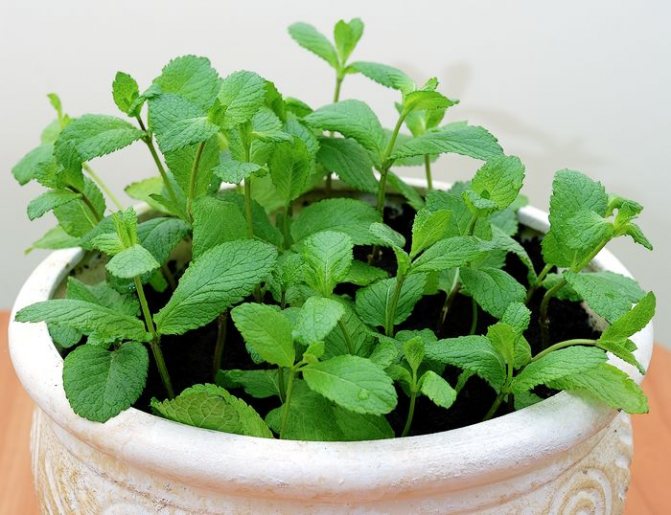

Planting capacity
You should be aware that mint grows in breadth, and does not go deep into the depths, so a wide container or pot would be an ideal planting capacity option.
Naturally, you must organize drainage: either there should be holes in the pot for draining, or a layer of expanded clay (2-3 cm) should be laid on the bottom.
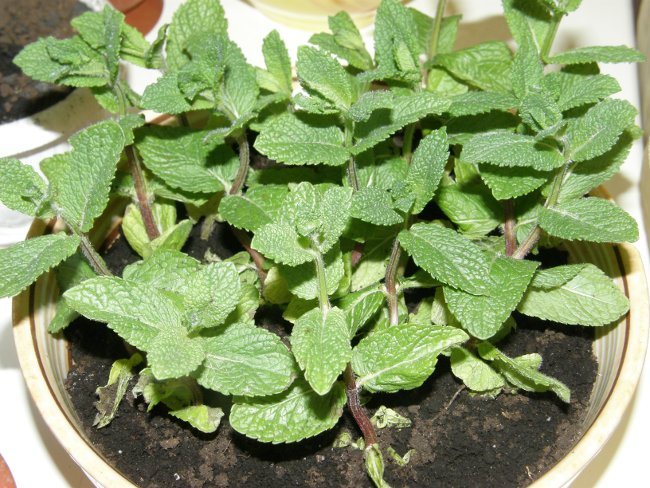

The soil
Mint is quite unpretentious in relation to the soil substrate, but for its more active growth, it is optimal to choose a loose and fertile soil. Buy the most common peat, add river sand to it, and your substrate is ready.
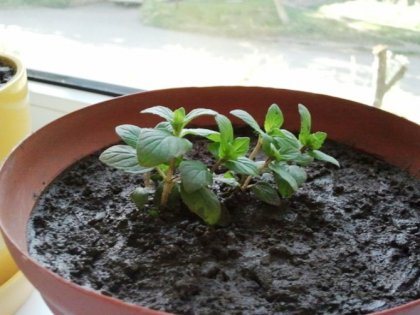

Choosing a site
The planting material serves as the basis for the future harvest. Therefore, special attention is paid to the selection of seeds and cuttings.
Mint seeds for planting are best purchased at specialty stores. Independently, even if it is possible to collect seeds, it is unlikely that it will be possible to grow a high-quality plant from them. Mint will have characteristics that are far from the original version.
It is easier to grow seedlings not from seeds, but from shoots cut from an adult bush. The side branch that extends from the central stem is cut at a distance of 1.5 centimeters from the central stem. The scion is placed in a glass of water. As soon as it starts up the roots, you can start planting in the soil.
Only healthy plants with straight leaves and a strong stem are suitable as seedlings. You should not choose bushes with sluggish wrinkled leaves damaged by pests for planting.
You need to choose a site that is well lit by the sun's rays, but not direct. Therefore, at noon, it is better if the site is in the shade.
The soil on the site should be fertile, loose with good aeration. If the acidity is high, then liming of the soil is preliminarily carried out (lime or wood ash is added). A loamy, sandy loam composition or black soil in the floodplain of a reservoir is considered ideal.
Ripening terms
Start cutting mint in June, when the shoots reach a height of 20 to 30 cm. However, the leaves are richest in essential oil before flowering. Pruning stimulates the awakening of the buds on the rhizome and the regrowth of new shoots, does not allow the plant to waste energy on flowers.
The active growth of mint continues until August. In three months, you can get 2 full harvests of fragrant leaves. Shoots grow "in waves": the very first are ready for cutting in June, others "ripen" by July or August.
Harvesting
Cut leaves can be immediately brewed with a pinch of black or green tea, added to dessert, or made into a cocktail. Such consumption of mint from a pot on a windowsill is available almost all year round.
Mint tops with flowers are not harvested for drying or freezing. They contain little essential oil and are therefore not suitable for tea or salads. Shoots before flowering are considered mature, suitable for mass collection.
Varieties for cultivation
There are infinitely many varieties of mint, each with its own special aroma - lemon, pineapple, grapefruit. Some people grow several different varieties in one pot at once, it looks very impressive.
| Krasnodarskaya |
|
| "Strawberry" |
|
| "Fun" |
|
| "Medicinal" |
|
| "Moldavian" |
|
For growing at home, mint varieties with small roots and not too spreading greens are chosen.
- Peppermint Vegetable fun is a perennial herb. The stem reaches 55 centimeters in height. Leaves are small in size, oval in shape, with carved edges. Greens are characterized by a pleasant aroma and refreshing aftertaste.
- The Pearl variety is characterized by a pleasant mint aroma. The dark green leaves are oval in shape, with a slightly wrinkled surface. The plant is compact and does not take up much space.
- The ceremony is distinguished by a delicate sweetish aroma. The stem extends up to 70 centimeters. Leaves are oval-elongated, with a wrinkled surface and light edging.
- Penniroyal is characterized by a creeping growth. On numerous shoots, small leaves with a pleasant delicate aroma are formed.
- The compact erect mint variety Moskvichka stretches up to 70 centimeters in height. Leaves are dark green with a weak edge. High immunity to many diseases and pests.
There are three main ways to grow any type of mint of your choice.
Growing methods
In order to grow fresh mint at home on a windowsill, you need to choose one of the possible breeding methods. A perennial crop can be obtained from seed, cuttings, or by using the root cuttings of the parent plant. Knowing the features of each method will help even novice gardeners cope with planting.
Seeds
A versatile way to grow mint at home. Planting material is sold in flower shops or harvested independently. Growing mint from seeds at home allows you to get delicate greens with a menthol aroma. At the same time, young shoots of the first year are slightly inferior in taste to an adult plant.
Mint, planted from seeds on a windowsill, gives the first harvest of greens in 2-2.5 months. A long and laborious cultivation method is used when it is necessary to obtain a certain plant variety.
Root layers
The new mint bush is grown at home from the roots of a perennial plant growing in a vegetable garden. The culture has developed superficial root processes with nodes of dormant buds. In the open field, fragrant grass quickly captures the territory due to the formation of new bushes from cuttings. To get a new mint bush at home, it is necessary to separate a section with 3-4 buds from the root system at the end of summer.
It is advisable to process the harvested material with a growth stimulator according to the instructions. The root should be buried 5-7 cm in the soil. The soil in the container should be moist and nutritious. At the bottom of the container, a drainage layer or holes must be organized through which excess water is drained. The first shoots should appear in 2 weeks.
Using cuttings
A perennial growing in a garden can be propagated by cuttings. This is the fastest way to get home mint greens from a garden plant. The vegetative method of propagation by cuttings is carried out throughout the summer, when there is enough green mass on the mother bush.
Part of the lateral stem is cut with a sharp knife at an angle of 45 °. A few upper leaves are left on the cuttings of mint, the lower ones are carefully cleaned. The shoot is placed in a container with water in partial shade. As soon as the mint releases roots 1-1.5 cm long, the stem is transplanted into the prepared soil. For several weeks, the seedling is protected from the scorching rays of the sun entering the house.
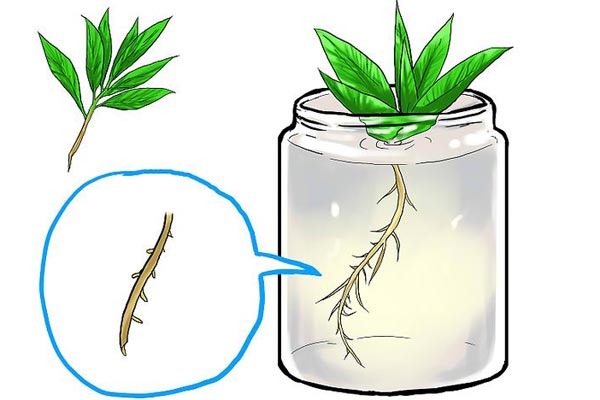

Plant varieties
There are a lot of varieties of mint for planting in the country. The easiest way to purchase planting material is in garden stores. One of the common plant varieties is peppermint. It was bred in the 16th century in England. The stems reach 1.4 m in height. The plant is lush, with long branches. Leaves of a light emerald shade, serrated at the edges.Peppermint begins to bloom in July and ends in September. The leaves are used to prepare teas and fish dishes.
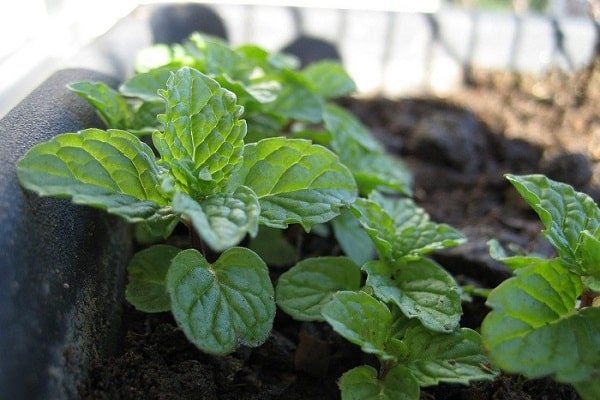

Another variety is curly mint. She got this name because of the leaves that look like curls. Plant height from 30 cm to 1 m. The aroma of the variety is not as sharp as that of pepper.
The chocolate mint variety has an unusual smell - a mixture of menthol and lemon with a touch of chocolate. The leaves are dark green in color with a purple tint.
Mexican mint has a spicy aroma. Plant height up to 1.5 m. It is used as a medicinal plant.
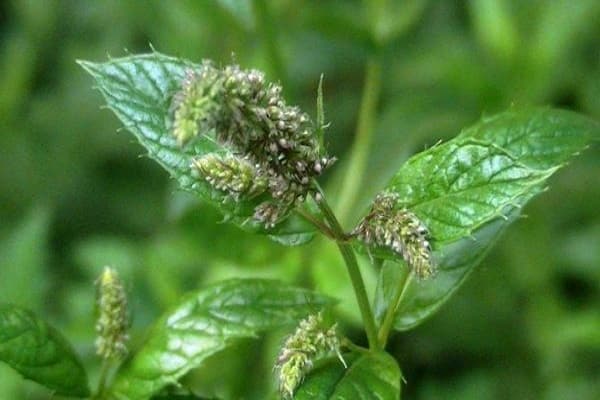

Prerequisites: lighting, temperature, humidity
Indoors, it is easier to provide a favorable temperature regime for mint, which is in the range from 20 to 25 ° C. In summer, with long daylight hours and bright lighting before lunchtime, regular watering, the plants give many new shoots and develop well. Mint should not be allowed to bloom on the windowsill. This takes away nutrients from the leaves, impairs the viability of the bushes.
Lighting in autumn and winter is more difficult, so mint often suffers from a lack of sun indoors. There is one-sided light on the windowsill, its intensity is lower than on the street. The mint pot must be rotated to achieve even growth.
The duration of lighting in autumn and winter should be at least 4 hours. If it is not possible to light up the plants, then it is necessary to transfer the pots to a bright room with a temperature of 15-17 ° С, reduce watering. Juicy, fragrant leaves will appear in spring and summer.
Water the mint regularly, twice a day during the hotter months. If the air in the room is dry, place a container with water for evaporation next to the pots. The need for watering decreases as the air temperature drops.
Digestive problems
Peppermint is ideal for aiding digestion. Mint leaves contain antioxidants and phytonutrients that are good for the stomach. The mint aroma helps to activate the salivary glands, which produce digestive enzymes, enzymes vital for digestion. They relax the abdominal muscles, which reduces the likelihood of stomach cramps and indigestion.
Peppermint leaves help clear acne and acne and give the skin a glow due to its high content of antioxidants. Also, the scent of mint soothes itching from insect bites. To do this, a mint leaf is rubbed at the site of the bite of a mosquito, midge, hornets, wasps and bees. The mint scent can repel insects to prevent new bites.
Preparing seeds and cuttings for planting
Peppermint seeds are best purchased from a local specialty store. Self-collecting seeds is a laborious and complex process. Even if it is possible to collect planting material, the plant will differ from the original version not only in appearance, but also in aroma and taste.
- So that the seedlings appear faster, the seeds are soaked.
- As soon as the first shoots hatch, they begin to plant in the soil.
- For a week, the container with seeds is covered with foil and removed to a warm, dark place.
- After the appearance of most of the seedlings, the container is moved to a bright place.
If it is supposed to grow mint by cuttings, then cut off the upper shoots of an adult plant, 10 centimeters long. The cuttings are first placed in water. As soon as the roots appear (after about 1.5 weeks), you can start planting in a prepared container with soil.
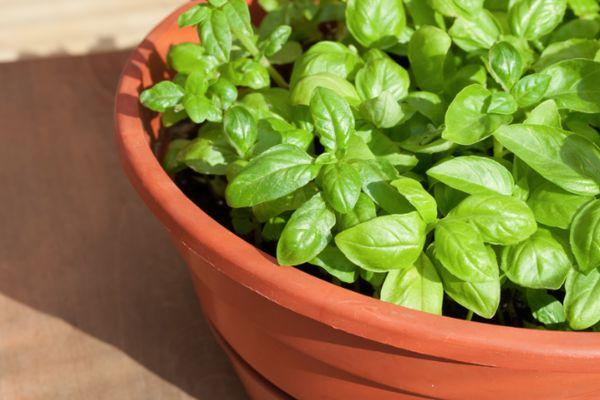

What should be the place
In the apartment, you should choose the most lighted window sill, best on the west or east side. Lack of light leads to stretching of the stem of the plant and a decrease in the content of essential oils. At the same time, the seedlings need to be protected from direct sunlight, which can burn greens.
The plant develops well at room temperature from +20 to +25 degrees. The spice loves humid air, so it is recommended to put a container of water nearby.
Where to plant
When choosing a container, you need to take into account the amount of the desired crop. If a few twigs are enough, you can use flower pots. To obtain a large harvest, a large container is required.
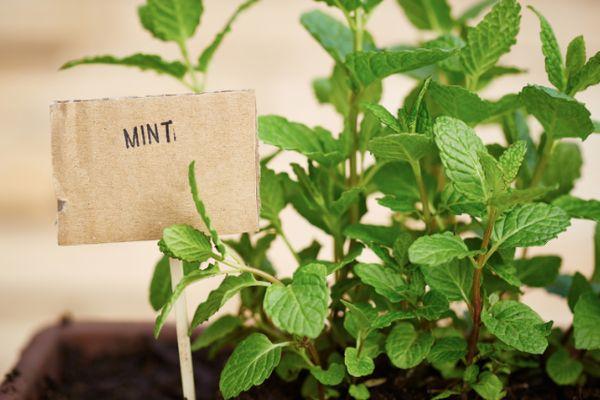

The mint root system does not go too deep in the ground, so it diverges close to the surface. It is better to choose shallow containers with a large diameter. At the bottom of the pot, holes must be made that will not allow excess liquid to stagnate. A drain is placed before filling the container with soil.
What soil to plant
The soil for mint should be loose, light, fertile, with normal acidity and high aeration. You can buy or mix the primer yourself. Humus, peat and sand are added to the ground from the garden. These components provide additional nutrition to the plant and improve oxygen access to the roots. Then the resulting mixture is calcined in the oven.
The acidity level should be neutral. Low acidity leads to a decrease in the content of essential oils in greens. Increased acidity causes the plant to develop slowly.
Accommodation and conditions of detention
For growing light and heat-loving mint, it is recommended to choose southern and southeastern window sills, which must be equipped with lamps for supplementary lighting of plants in the evening and cloudy weather. Daylight hours for the culture should be about 6-7 hours, otherwise the mint is strongly stretched, fades and may die.
Under natural conditions, the culture is not too demanding on the soil, however, for home cultivation, a mixture of purchased universal soil and garden soil (1: 2) is best suited. Before preparing the substrate, the soil from the dacha must be calcined in the oven or poured abundantly with boiling water in order to prevent the development of infectious agents and larvae of earth parasites.
At the initial stage, mint is grown in a common container equipped with drainage holes, after which the grown seedlings are seated in separate pots. In order for the powerful mint root system to have enough space for full development, it is recommended to choose spacious planting containers with a depth of at least 30 cm.
Fragrant greens can be grown on the windowsill in several ways, each of which is effective and successfully practiced by experienced gardeners.
Care
You can plant mint outdoors in spring and autumn, after which the plant must be properly cared for.
- Autumn planting should be carried out in late September - early November, so that the grass can take root before the onset of cold weather. In order to avoid freezing of the root system, young plantings should be mulched with a layer of peat or sawdust 15 - 20 cm thick. In spring, mint is planted after the soil warms up well and the threat of frost passes.
- After planting, it is necessary to regularly water the bushes so that they take root well and take root in a new place. Watering should be done as the soil dries up.
- Peppermint loves moist soils, but should not be allowed to lock for a long time. High humidity leads to decay of the root system and to fungal infections. Regular watering should be organized during the dry season so that the plant does not start to wither and wither. Irrigation water should be at ambient temperature. Cold spring water negatively affects plant health. Watering should be carried out in the evening.
- At the beginning of spring, mint can be cut at the root so that it bushes better and does not stretch in height. Periodically, you need to transplant bushes, in one place the grass can grow no more than 5 years.
- Overgrown plantings need to be thinned and weeds removed regularly to ensure normal air access to the mint roots. The soil must be periodically loosened so that a crust does not form on it.
Like other crops, mint needs fertilization and feeding.Complexes of mineral fertilizers, which can be purchased at a flower shop, will help saturate the soil with nutrients and trace elements.
The composition of the dressing must necessarily include calcium. Granular fertilizers are applied to wet soil after watering. You can dissolve the granules in water and inject into the soil at the root. Rotted manure or humus is applied as organic fertilizers.
Top dressing of mint should be carried out in early spring, as well as in summer, when the plant is actively growing foliage and blooming. Autumn dressings are carried out before frost. To do this, rotted manure is introduced into the soil in an amount of 2 kg per 1 sq. m landing.
Exotic varieties
Doggy
People call it ivy bud, or dog mint, the plant stands out with a persistent aroma. Grows in Eurasian fields, in a zone with moderate climatic conditions. It stands out with a bitter and pungent aftertaste, does not leave a cold aftertaste. This medicinal plant can be attributed to the melliferous type. It is widely used for its anti-inflammatory, choleretic, healing effects. Leaves are actively used for the manufacture of various tonics.
Read also: What plants are ants afraid of
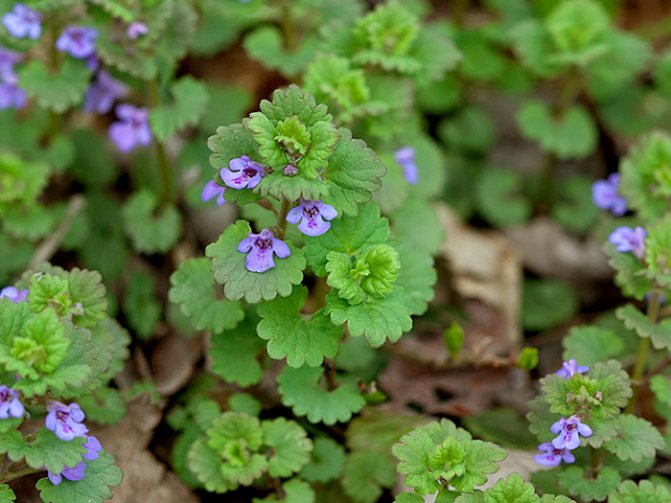

The height of a mature plant reaches a maximum of 40 centimeters, its stems actively crawl over all surfaces, they are complemented by naked or pubescent short hairs. The main vegetative organ of the plant is numerous, rooting. Its leaves contain long petioles, and are distinguished by their shape in the form of buds or roundness, located opposite. Small flowers with a purple or bluish tinge are collected in inflorescences and can be enjoyed until mid-August.
The mint plant found its way into medicine in ancient China. It stands out for its regenerating action. It is also used for stagnant bile, as a remedy for hyperhidrosis, or even as a deodorant. From this variety of mint oil is made, which is optimal for treating eyelid skin.
Cat variety
This type of plant is distinguished by a strong uncharacteristic scent of lemon, which attracts all stray cats in the area. Mint mainly grows in forest clearings, wastelands, weedy places, on the slopes or along the side of the highway. Most often it grows close to belts, because it is considered a valuable honey plant. The plant has found its application in the perfumery field, in the preparation of soap, in the confectionery shop and, of course, in pharmacology. Dried leaves and inflorescences of the plant help to overcome diseases of the gastrointestinal tract, they are brewed with severe migraines, the areas of the skin affected by rashes or allergic reactions are wiped with an extract.


This species of mint is a perennial representative of the flora, capable of growing up to a meter in height. Its roots are like woody species with straight and sturdy stems. The flowers are dirty pale in color, they can be pinkish or purple. The entire inflorescence is collected in a specific umbrella at the tips of the vegetative organs of higher plants.
Harvesting mint
To add to teas, salads and other dishes, mint leaves can be plucked throughout the season. Fresh herbs keep well for several days in the refrigerator.
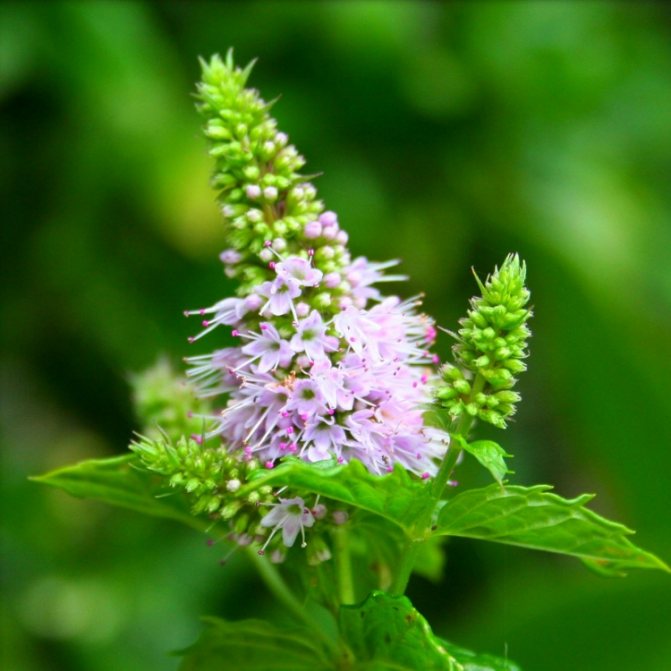

It's time to harvest
The preparation of herbs for storage is carried out during the budding period. At this time, the plant accumulates the maximum amount of essential oils. When harvesting, adhere to the following rules:
- no need to break off the bushes at the root - it is better to cut off individual leaves or cut (pinch off) the apical branches, this stimulates the development of new shoots;
Important! For grass harvesting and drying, dry, cloudless weather is chosen.
- the collected raw materials are laid out in 1 layer on clean paper in the shade of trees, under a canopy or in an attic with good ventilation;
- when the mint dries, it is ground into powder or packaged as it is.
Mint is stored in a cool, dark place in a sealed container (wooden or glass). In this form, the raw material will retain its properties for 2 years.
For the entire growing season, summer residents manage to harvest 3 crops of mint greens. The last call should be no later than mid-August, otherwise the plant will not have time to accumulate nutrients for wintering.
Not knowing how to grow mint from seeds, it will be difficult for a summer resident to ensure the correct development of the culture. If you want to get a quick easy result, then it is better to propagate the plant by dividing the rhizomes or by cuttings. In any case, it is not difficult to care for the culture.
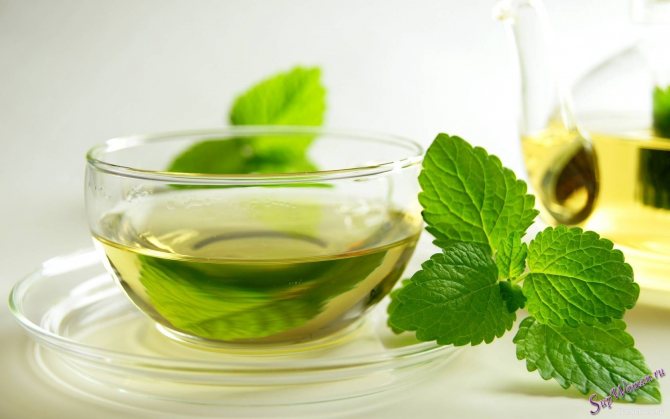

Fragrant mint tea
Pests
In summer, mint's enemies are pests - spider mites and aphids. They attack with constant drying out of the soil and surrounding air. If the plant has already become infected, you can use drugs that are used to treat flowers.
The plant is very afraid of direct sunlight, resulting in burns and, as a result, drying or death of mint, so try to remove it in the shade or shade a window or balcony. But, without good lighting, the stems become very elongated, and the leaves are weak. You can put a sheet of frosted glass between the mint and the sun.
The pronounced aroma of menthol repels many harmful insects from mint. The danger is posed by the mint flea and leaf beetle. Small pest larvae can get home with garden soil. Insects feed on young shoots and mint roots, weakening the plant. Regular inspection of foliage and soil surface helps to identify the hazard at the very beginning.
The mint flea is a yellow beetle, 1.5 mm in size. On the affected plant, there are round holes that are gnawed by the insect. The dangerous beetle is destroyed by spraying with Aklektic.
The attack of the leaf beetle is recognized by the accumulation of green bugs with a glossy sheen on the stems and axils of the leaves. Pests draw out the juice, provoking drying and dying off of the shoots. An effective means of control is the treatment of plantings with a Chlorophos solution.
At home, on the windowsill, in high humidity and cool air, mint can be susceptible to fungal diseases. The appearance of red or brown spots on the back of the leaves is a sign of rust damage. A whitish bloom on the front side of the shoots indicates a disease of mint with powdery mildew. At the initial stage of fungal disease, the leaves must be treated with fungicides.
Soil selection
Mint prefers light, loose and fertile soil. In heavy and clay soils, as well as in places with stagnant moisture, the grass does not take root or grows very poorly. The plant is well suited to sandy loam or loamy soil, rich in humus. The optimum level of soil acidity is 6.0 - 7.0.
Before planting, the soil must be well dug up and the area must be cleared of weeds. You need to try to get rid of the weeds right away so that their root system does not interfere with the rooting of mint.
To enrich the soil with elements useful for growth, during the digging process, the following fertilizers must be added to the soil per 1 sq. m:
- humus - 3 kg;
- superphosphate - 15 g;
- ammonium nitrate - 15 g;
- potassium chloride - 15 g;
- wood ash - 30 g.
To prevent the plant from growing, you can put limiters by digging sheets of slate or iron into the ground to a depth of 30 - 40 cm. As a result, the root system of the plant will be within the fence and will not interfere with the growth of other crops.
It is necessary to limit the spread of roots in the soil when mint is planted in a flower bed for decorative purposes. If this is not done, the grass will very soon fill the free space and begin to displace the flowers. To make the mint look aesthetically pleasing and not interfere with the growth of other plants, it can be dug into the flower bed along with a pot that will limit the spread of roots, and the bush will have a neat appearance.
For planting seedlings, holes are made with a depth of 10 - 15 cm at a distance of 30 - 40 cm from each other. Sowing mint is carried out in grooves 5 cm deep. Seeds are spaced from each other at a distance of at least 30 cm. The distance between rows should be 50 cm. The rapid growth of bushes will soon lead to filling the free space.
To make the beds with mint look neat, and the plants are thick and low, 10-15 days after planting the seedlings, you need to pinch the tops. Correct pinching is carried out when the plant has reached 20 - 25 cm in height.
Growing mint with root layers
Long, diverging roots of mint have dormant buds. Therefore, the plant can be propagated by means of root layers. Below is the instruction:
- At the end of summer, take root cuts up to 12 cm long, with 2-3 buds.
- They are immersed in moist soil by 5-6 cm.
- If the buds have already woken up at the root, released shoots, then the aerial parts after planting are cut off about 5 cm from the top.
- The buds wake up, sprout on average 2 weeks after planting.
Care after landing
Mint, like lemon balm, is not a demanding plant, which is why its cultivation is so common at home. But to ensure good survival of seedlings and abundant growth, special care is required for it, which should include the main activities:
- Removal of weeds during periodic weeding and loosening of the soil in a pot or container for planting seedlings.
- Moderate watering, the frequency of which depends on temperature and humidity. For example, when grown in winter, the plant requires moderate watering, and in hot summer, abundant watering.
- Application of mineral fertilizers containing nitrogen and phosphorus, which help maintain vitality.
- A plant transplant, which is necessarily carried out once every two or three years. This procedure rejuvenates the plant and ensures good growth and development.
Planting mint requires careful adherence to all these care requirements at first, until the mint gets stronger and stronger. Subsequently, she ceases to require such attentive care.
Plant species of mint
Meadow or field plant
It can be found in European, Asian, Caucasian, Indian or Nepalese markets. It also grows along river banks, close to other bodies of water. The essential oil has a specific pungent smell and a sugary, bitter taste that combines menthol and various citrus notes.
According to the experiments carried out, it was brought that a person who inhales the aromas of this variety of mint will reduce the consumption of fats, proteins and carbohydrates several times within 24 hours. The plant is used as an additive to dishes, in the pharmacological field (treats bloating, stomach inflammation, heartburn).
Ginger type
Among all the varieties of mint presented, it is worth highlighting ginger, which is growing so far, which is mainly in Egypt. Has no unpleasant numb aftertaste. According to the recommendation of traditional healers, the flowers of the plant, after preliminary drying, are taken for inflammation of the gastrointestinal tract. Helps to overcome meteorological dependence, soothes the shattered nervous system. The stems are distinguished by four edges, in addition, they are straight and branched with a horizontal and well-developed root system. The leaves of the plant are wide, at the ends they become pointed with an elongated ovoid shape.
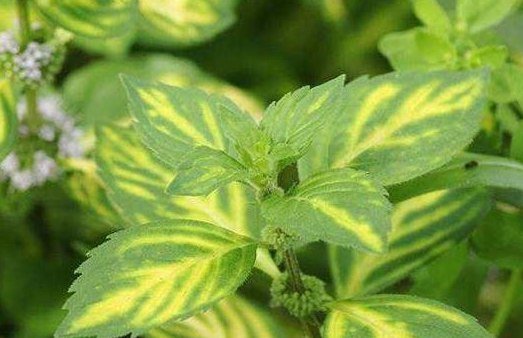

The plant is often grown for decorative purposes and all thanks to its fiery and greenish hue. Small-sized flowers that gather in woven branches, as a result, inflorescences are formed in the form of spikelets of a pink or purple hue.
Mint with chocolate aftertaste (chocolate)
The plant grows quickly in places with high humidity, prefers light soil, rather aggressive, but practically does not require any additional care. It stands out among other varieties with a pleasant taste and sweetish aroma. It is resistant to insect attack, as well as to subzero temperatures. With the necessary light, the sheets are painted in a dark purple color.
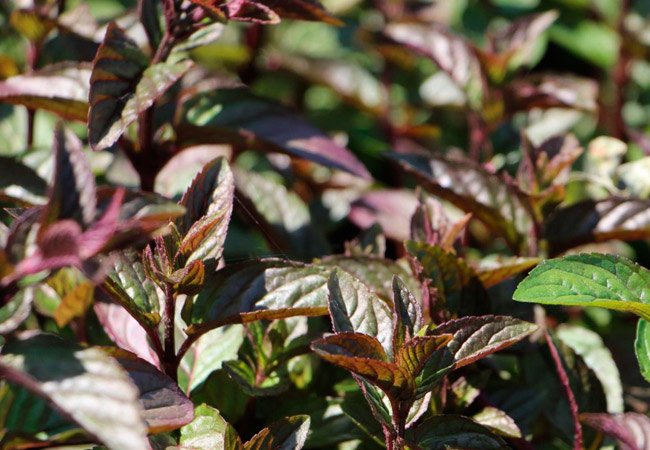

This type of mint is often grown for decorative purposes. But, due to the increased content of essential oils and a pleasant chocolate taste, it is used for confectionery purposes and in pharmacology.
Lemon (lemon balm)
This fragrant plant is also called honey slipper, mead or lemon balm. Lemon-flavored mint gives off a pleasant and refreshing citrus flavor. It grows on southern European and Mediterranean plantations.
This plant stands out for its value, taste and medicinal properties, it contains a high concentration of vitamin C, pigment, unsaturated hydrocarbon from the class of carotenoids, and aromatic substances. For centuries, mint has been cultivated as a honey plant. This plant belongs to the class of perennials, it begins to bloom in the summer, and the fruits ripen after about a season.
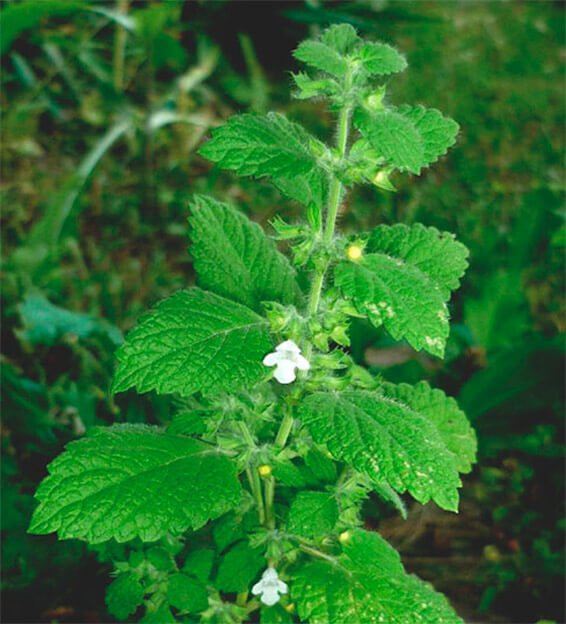

If you pay attention to the plant itself, then its height can start from 30 centimeters and reaches one and a half meters. The branching of the stem or lateral shoot is short, the flowers are blue, snow-white or light purple, the upper leaves are located in the axils. The large black fruit can be used as seeds for three years.
This plant is quite winter-hardy, but in severe frosts it is advisable to cover the soil with a layer of peat.
Despite the fact that there are different varieties of mint on the market, they all have common advantages. The main thing is, among all the abundance of goods, choose the one that you really need and that is suitable not only for pharmacological characteristics, but also for price. Peppermint itself is a valuable medicinal plant, but if added with a lemon, ginger or chocolate aftertaste, it can be actively used in cooking, in the preparation of cooling and low-alcohol drinks.
Care features
Caring for a home mint bed consists of activities such as:
- Watering - the soil under the plantings is moistened as needed, preventing the surface layer from drying out too much.
- Loosening is a procedure that ensures timely access of oxygen to the root system.
- Spraying - in conditions of increased dry air, it is necessary to carry out water procedures for mint at least 2-3 times a week. When located near heating devices, the plant pot can be placed in a tray with wet pebbles.
- Top dressing - after transplanting into separate pots, the plants are watered with a solution of complex fertilizer. In the future, dressing for mint is necessary after each mass cutting of greens.
Under favorable conditions, peppermint provides healthy aromatic greens in the diet throughout the season.
Tags: mint, windowsill
About
«Previous post
Propagation by cuttings
The easiest way to propagate mint is vegetative. In the fall, before the onset of frost, several young healthy shoots are taken from an adult plant, which are placed in wet sand for rooting. As soon as the first root shoots appear, the cuttings are planted in the ground in a separate bowl. To help plants adapt more quickly to a new place, they can be covered with a glass jar or a plastic bottle, cut in half.
The method of growing by cuttings is more convenient and simple. It allows you to harvest greens in a short period of time. In addition, almost all types of mint (not counting water mint) are suitable for propagation by cuttings. It is recommended to harvest cuttings in the fall, when the growing season of plants is over.Dig out the rhizome along with the earthen lump and store it in the cellar until planting, sprinkle it with sand on top.
Before planting the mint on the windowsill, divide the rhizome into several parts. Each part should have suckers with dormant buds. Plant the cuttings in boxes or flowerpots filled 2/3 of the volume with the substrate. The planting depth is about 5 cm. The distance between the cuttings is about 15 cm. After laying the root system, water it abundantly and cover it with the same soil.
Growing mint from cuttings is extremely simple and even easier than growing from seeds. To do this, you need to buy (or take in the garden) a strong stalk, which is placed at home in a glass or glass jar for germination of the root system. Plastic containers are not recommended for use.
Video about growing mint on a windowsill
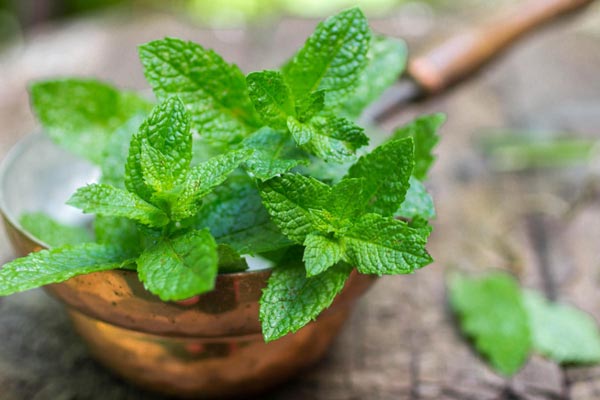

Experienced gardeners advise putting a gauze-cotton pad on the bottom of the container, which imitates the soil and immediately gives more branched roots. As soon as the roots reach a length of at least 7-10 mm, the stalk is transplanted into moist soil, and the plant is placed in a sunny place, but for the first months it is protected from direct rays with a white translucent cloth or thick gauze.
Plastic container is not recommended for use
Mint propagates in only two ways: by dividing the root and sowing seeds.
Cuttings are easier to use for reproduction, and they are easy to save. In the autumn period at the end of the growing season of the plant, the rhizome is dug up, preferably with a lump of earth, dropped into any container with sand and stored until spring or late winter.
Next, take the cuttings and divide the rhizome into as many parts as there are dormant buds on the roots and plant them in prepared containers, carefully distributing the roots at the bottom, and the buds should look up, filling two-thirds of the entire planting area with earth, thoroughly saturate the soil with water, then completely fill everything to the top with soil.
It is also easy to grow mint from seeds, seeds are bought or removed from cultivated species on their own. Seeds are sown into the ground, prepared grooves up to 5 mm deep. In 2-3 weeks you will see shoots. Control the temperature. The optimum temperature for plant development is 20 ... 25 degrees Celsius, and seeds germinate at 10 ... 12 degrees.
We suggest you familiarize yourself with: Tetracycline for broiler chickens dosage with water
Description of the plant
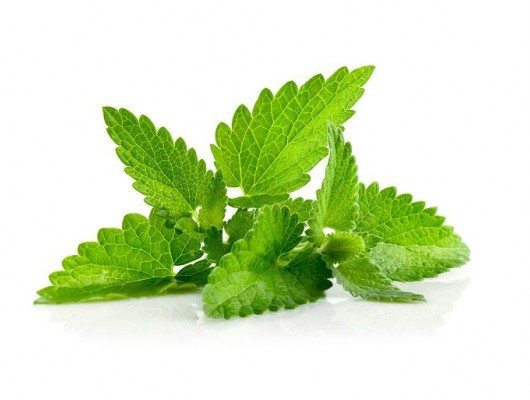

Peppermint is a fragrant plant, its essential oil is used in perfumery, medicine and cosmetology. It represents bushes 35-110 cm high. Raw mint contains a lot of menthol, carotene, tannins and resinous substances, glucose, saponins and several types of natural acids (coffee, ascorbic, chlorogenic, oleanolic and ursolic).
Suitable species, varieties and varieties
Mentha is a genus of perennial grasses of the Lamiaceae family. Many shoots extend from a branched rhizome, located almost horizontally, and thin roots. Mint is used as a pot and container plant. The main thing is to provide adequate lighting, regular watering.
Mentha piperita - M. pepper
It is a hybrid of two natural species (M. spikelet and M. aquatic). The stem is 20 to 60 cm high, tetrahedral, branched, densely leafy, reddish at a young age. The leaves contain a variety of essential oil glands.
Spikelet inflorescences are located in spike-shaped inflorescences at the tops of the stems. Corollas are small, pale purple, lilac or pinkish. Flowering begins in June and lasts until autumn.
Peppermint is rich in menthol. When rubbed or touched while leaving, the grass emits a pleasant aroma-chill. This hybrid is popular as a tea, medicinal, cosmetic plant.
Peppermint subspecies: black with reddish-purple hues, white with light green stems and leaves.Black mint is grown for the industrial production of essential oils and menthol. The essential oil of the white variety is more delicate.
Window sill and balcony varieties:
- "Lemon", "Orange", "Bergamot". The leaves are rich in menthol, antioxidants, used for drinks, decorating various dishes, improving the taste of sauces, compotes, jams. The aroma corresponds to the "speaking" names.
- "Apple". Leaves with a delicate taste, fresh apple notes. The variety is popular for fresh salads, drinks, ice cream.
- "Strawberry". Suitable for balcony cultivation. The leaves taste like ripe strawberries.
- "Chocolate". Leaves with taste and aroma of mint chocolate. Fast growing variety.
It is difficult for a layman to recognize a plant without a label, "badge". You can choose according to the description the most suitable in height, requirements for care, use.
Other popular types and varieties of mint
Spikelet M. is a plant with curly leaves. Pubescence in the form of short hairs. The flowers are white or pinkish. The species is poorer in essential oil and menthol than modern varieties, therefore it is less valued in medicine and cooking.
Water mint is a plant up to 90 cm high, with pink globular inflorescences, ovoid leaves and pubescent stems. Long-leaved M. has an impressive size (up to 1 m and more), more suitable for growing in the garden.
The varieties of mint "Banana", "Pineapple" are obtained on the basis of several species and hybrids. Use the leaves with a delicate fruity aroma and delicate taste for sweet dishes and drinks. Mojito is especially good for soft drinks. Moroccan mint, which is gaining popularity in Western Europe, may lack sun in central Russia.


Contraindications to the use of the plant
Mint, like any medicine, can negatively affect the health of the body. Therefore, it is important to know when to stop using mint in any form. Can not use:
- if you have hypersensitivity to menthol;
- driving (causing drowsiness);
- with the simultaneous use of anticonvulsants, antifungal agents, antibiotics,
- preparations containing iron, medicines to lower blood pressure;
- inside for children under three years old;
- with varicose veins.
Uncontrolled use of mint can lead to heartburn, as well as a decrease in male potency.
Reproduction methods
Natural species easily reproduce by pieces of rhizomes give small seeds that are carried by the wind, water, animals. Seed propagation of almost half of the hybrids at home is available only to the most experienced growers. When choosing the most suitable plants for the windowsill, it should be borne in mind that the methods of propagation and care of different varieties of mint are very similar.
You can buy seedlings or an adult potted plant from specialty stores and garden centers. Houses should be planted or transplanted into a larger pot or container.
- Sowing seeds (not for all hybrids and varieties).
- Cuttings, rooting of green shoots in water or wet substrate.
- Planting pieces of rhizome with buds and roots.
- Division of the mother bush
The advantage of vegetative methods (the last three numbers in the list) is that the resulting young plants always inherit the varietal qualities of the mother bush. If you collect the seeds yourself, they will not sprout or look like the original variety.
Seeds
Mint hybrids prevail in modern floriculture - they are richer in essential oil, more decorative. However, during the breeding process, plants often lose their ability to produce germinating seeds. Therefore, this method of reproduction is not for everyone. If you buy quality seeds from a flower shop or garden center, it is easier to get strong seedlings of your favorite variety.
- Fill a pot or container with loose soil.
- For even distribution, premix the seeds with clean sand.
- Moisten the soil with clean water from a spray bottle.
- Sow seeds to a depth of no more than 5 mm, sprinkle with soil.
- Cover the container with a plastic bag or plastic wrap with holes for gas exchange.
Mint seeds germinate best in warm, moist soil. Seedlings appear in 2-3 weeks. If sown on seedlings at the end of February, then in March in March the first shoots are visible. Prepare containers and soil for future bushes in advance. When 2 true leaves appear on the sprouts, transplant the strongest plants into separate containers or one large pot. Elongated, withered, yellow - discard.
An adult bush
It is not necessarily a large plant. The first green shoots of mint after wintering in a room on a windowsill may be weak. The main thing is that the underground part has living buds and roots. Divide the large bush into several parts. Sprinkle the cut points with crushed charcoal.
What do you need to grow mint?
Growing mint at home must be approached with certain knowledge. The seedlings require suitable planting containers and soil conditions. It is important to take into account the temperature and humidity indicators at which the culture will grow safely.
Choosing the best place in the house
Choosing the right sill is essential for the full growth of your seedlings. The plant likes places with sufficient sunlight. But the light should be diffused, not direct, since the intense rays burn thin seedlings. Therefore, the best option is to install the pot on a western or eastern window sill.
Selection and preparation of containers
The mint root system is characterized not by deepening into the ground, but by expansion. Therefore, you need to choose not deep, but rather wide planting containers.
The bottom should be equipped with drainage. If there are no drain holes, they are either made independently, or a claydite layer up to 3 cm thick is used.
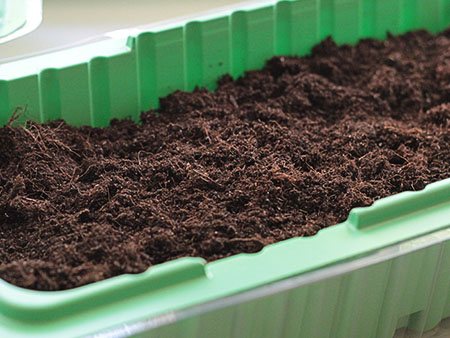

Soil selection
Mint is picky about the soil. But in order for it to grow more actively, it is advisable to make a nutritious soil with a loose structure. The best option is a mixture of peat and fine sand.
Preparing seeds and cuttings for planting
You can plant a non-capricious plant by the following methods:
- Seeds;
- Root layers;
- By cuttings.
How to care?
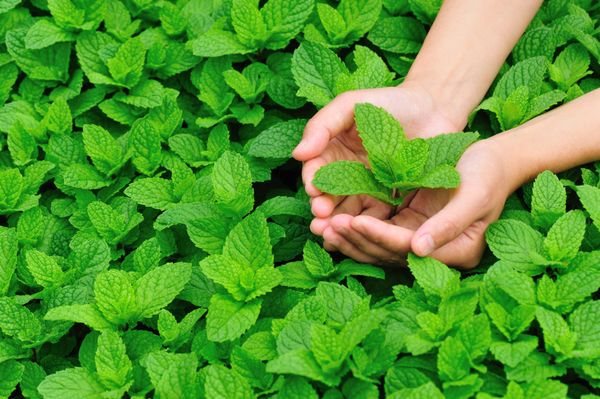

To grow lush, fragrant mint bushes, the following conditions must be met:
- Plant the plant in acidified peat-based soil. Therefore, if you plan to use purchased land, you need to choose a peat substrate, and if the land will be collected from the garden, it is better to choose a fat and dense soil.
- It is important for seedlings to provide high-quality watering, but for this to use rainwater.
- The land around the bushes needs to be hilled as it compresses, weeds must be removed.
Experienced gardeners recommend planting mint seedlings in the place where legumes (peas, beans) or root crops (carrots, beets) previously grew.
The subtleties of collecting greens
Peppermint greens can be removed at home just before adding them to meals or drinks. You can pluck both individual leaves and apical shoots, which contributes to better tillering of the crown. So that the bush does not look one-sided, and the new greenery grows faster, the leaves are removed from different sides, retreating 0.5 cm from the leaf sinuses.
Fresh peppermint greens are used to decorate and flavor all kinds of dishes, cocktails and pastries, and a lush well-groomed bush looks very decorative in the interior and fills the house with a spring scent.
You can harvest home-grown spices throughout the year. Young leaves have a pleasant aroma and are used in cocktails, desserts or teas. The level of essential oil in them is lower than in older shoots. Early pruning allows the formation of a bush and encourages lateral growth.
After the onset of technical maturity of the shoots, from the beginning of budding, they collect, harvest, store mint for medicinal use. The stems are cut at a distance of 7-10 cm from the ground. Tied together in bundles and hung in a dark room with ventilation. Dried mint is stored in canvas bags or glass jars. More nutrients are stored in a sealed container.
Fresh, vitamin-rich greens from the vegetable garden are available mainly during the summer months. By planting mint at home on the windowsill, you can provide yourself with a fragrant spice for all seasons.
Growing mint from seeds
Seed propagation is the most difficult thing. But this method is necessary if you need a specific type of mint. It is advisable to use purchased seeds. When bred from self-harvested seeds, varietal genes are not always inherited. Below is a step-by-step description of the seed method of planting mint on the windowsill:
- The procedure is performed in March or April.
- The seeds are immersed 5 mm into the moist soil, and they are covered with a thin layer of peat on top.
- The pot is covered with glass or polyethylene.
- Do not allow waterlogging or drying out of the soil. The surface soil layer is sprayed if necessary. The glass is periodically shifted so that the soil is not refracted.
- Seedlings are shown on the 15-18th day. When development reaches the stage of two true leaves, young greens are planted in separate containers.

